|
Home
Curriculum Vitae
McCall Glacier
Overview
Field Blogs
Data
Photography
Older Projects
Personal
Contact
|
McCall Glacier
-- May 2011
|
Photo credits: The photos
here were shot by me, Keith, and John; right click on an image
and hit save to see who took it (mine are the only ones without
a name), then cancel the save if you dont want it.
3 May 2011 Coldfoot
The trip hasnt gone exactly
as planned thus far, but we're not too far off schedule yet.
This trip is a bit unusual
for us as it involves more personnel transfers than normal for
such a short trip. If just planning for my research, I would have
started the expedition about 2 weeks earlier, as it's my impression
is that the weather is a bit better in April for flying and it
is also a bit colder so makes coring easier. However, working
with other schedules pushed things back a bit. Andy Reese has
been studying pollen on the glacier since 2008. He teaches classes
and was not able to break away until they finished, which is not
until the end of this week, about the 10th. He's also bringing
a grad student, Michael Ewing, who is working on much of the data,
and has classes to take. Given that the lake coring they want
to do is best done early, we decided that I would try to get most
of this done before they arrived and then they would help me with
the glacier ice coring and other tasks. In the meantime, Keith
Mountain was going to arrive on the 4th to both help me and them.
I've known Keith since 1992 when I was on the JIRP expedition
that ultimately led to me getting a PhD at UAF, and he was also
responsible for steering Andy towards McCall Glacier for studying
pollen. He joined Andy on his 2008 trip to the glacier, which
had some pretty screwy logistics, and he is now starting to take
over much of our mass balance modeling which is his area of expertise.
Prior to all this, John Carlson was due to arrive to make a short
film about our expedition and ice coring, leaving with the flight
that hauls our ice cores from the glacier back to Fairbanks.
The trip began about 5 days
ago, when John showed up in Fairbanks. John is a film maker I
met through Tom Veltre. Tom and I met in the DC area in January
at the 50th Anniversary Symposium of the Arctic National Wildlife
Refuge, where he was premiering his latest film on George Schaller
and Kristin and I were giving a talk about our research in the
Refuge. We began conversations then about making a film about
our research and its relevance to the local ecology. Over the
next few months we put together a plan to do some initial filming
on this trip to better assess what the possibilities are.
By the time John arrived, most
of our preparations were completed and it was mostly a matter
of getting everything packed and loaded for our drive to Coldfoot.
We left Saturday morning, April 30, with 3 trucks, two of ours
and Mike McCrary's from 70 North. Mike and 70 North are coordinating
our logistics for the summer for all of my projects in the area,
doing much of my flying their Helio Couriers. My goal on this
trip was trip was to shed much of the load of logistical craziness
onto 70N. Unfortunately, despite starting the process in February,
my contract with them was only finalized a few days ago and thus
everything was up in the air until then, which caused them and
Coyote Air to be left in limbo in terms of planning until then
and thus the state we are in now. The drive to Coldfoot went as
planned with no breakdowns or other delays. It was 8PM by the
time we got here, though still plenty of light due to our northerly
location. We sorted gear that evening and reweighed our totals,
confirming that we had about 3 loads to bring in.
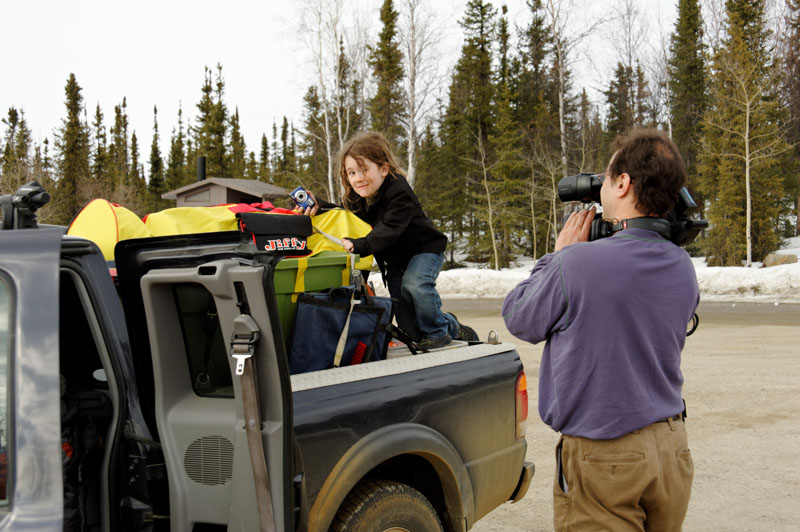
Turner can't resist an opportunity to climb on top of
the truck; we probably could have left him up there the rest of
the trip.
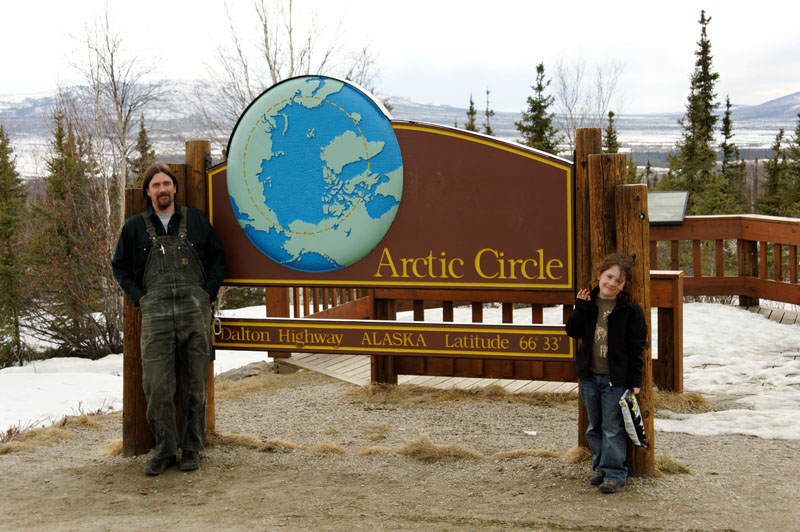
The obligatory photo op.
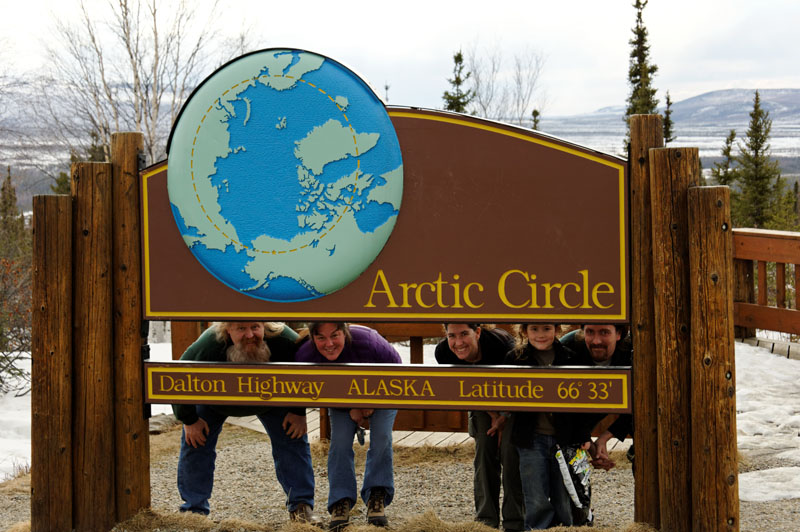
The more the merrier.
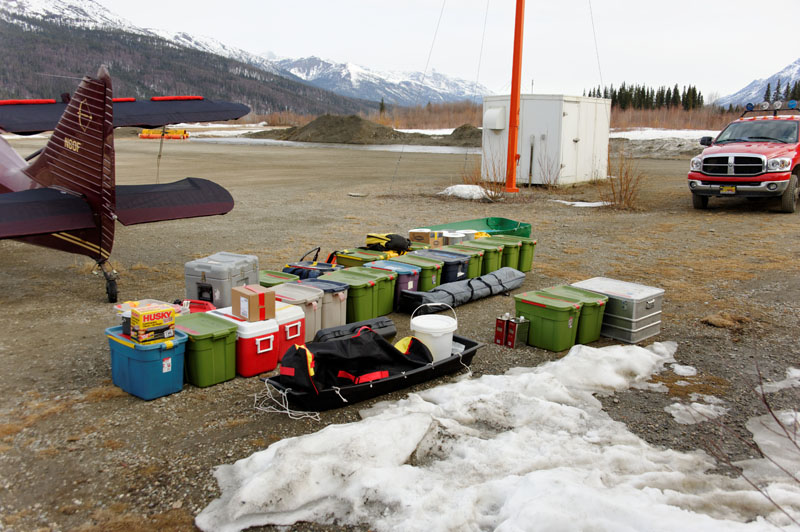
Our gear for the trip. Food for 6 for 3 weeks and science
stuff.
Our original plan for this
trip is that Dirk would fly in one load per day in the mornings,
and afterwards we would spend some time on the tundra coring sediments
at the bottom of lakes. Our goal here is to analyze these sediments
for their pollen content, essentially using the lakes as large
pollen traps. By examining the pollen in the area around McCall
Glacier, we will be able to better interpret the pollen we find
in our glacier ice core for spatial and temporal variations. So
we have a lake ice drill, typically sold to ice fisherman, to
get through the lake ice and then we lower down through that hole
a sediment coring device to grab the pollen samples. We had decided
to do this at the beginning of the trip to avoid any issues with
melting snow or lake ice, to ensure that we could land and take
off there. In the meantime, we would be getting camp up and functional
on the glacier, such that by the time the other team members arrived
we could begin our glacier work. Our highest priority glacier
work is to continue the shallow ice coring that we began in 2008.
Here we are trying to track how the snowpack changes over time
due to the percolation of meltwater into the lower snowpack and
its refreezing there. This process of internal accumulation blurs
the annual signals retained in our deep ice core recovered in
2008, as this process has likely been occurring for hundreds or
thousands of years. So essentially by tracking the changes in
the 2008 snow layer as it gets buried, we will have a better sense
of how this process has affected all of the older layers in our
core by analogy. We want to finish this coring as early as possible
in the trip, so that we can send the cores back to Fairbanks while
its still reasonably cold. Afterwards, the plan is to take care
of our baseline measurements like mass balance and ice velocity,
install some pollen traps to collect airborne pollen on the glacier,
test out some new ice radar equipment, maintain our weather stations,
and get our weather station telemetry functional again.
The weather the next day was
marginal everywhere north of us. We spent the day milling about,
waiting for weather updates. Unfortunately the telemetry of my
weather stations on the glacier had died sometime over the winter,
and thus we had no local observations. In this huge area of the
state, there are no weather stations or other information like
cameras within the mountains, so the only weather observations
we have are about 60 miles to the north or even further to the
south. Unfortunately these stations typically do not experience
the same weather as our site in the heart of the mountains. Plus,
we need good weather extending to at least 8000' so that we can
clearly see our ski-way for landing. By about 4PM we called it
quits for the day, and enjoyed a little kite flying on the ramp
in the afternoon breeze, and later gave my tiny new HD video camera
a test ride on the hood of my car. Turner got to spend the day
playing his new Nintendo game, which made him very happy, and
we enjoyed a spaghetti and meatball dinner on the deck of office
in the warm evening sun. |
|
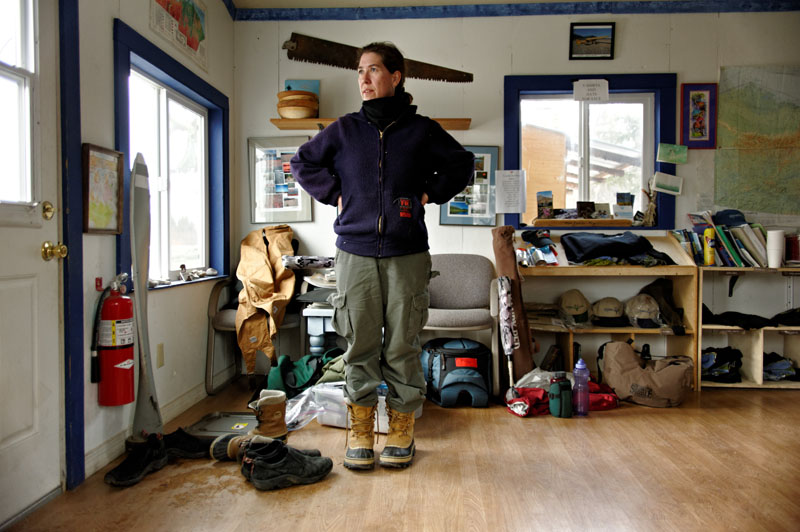
Checking the weather. |
|
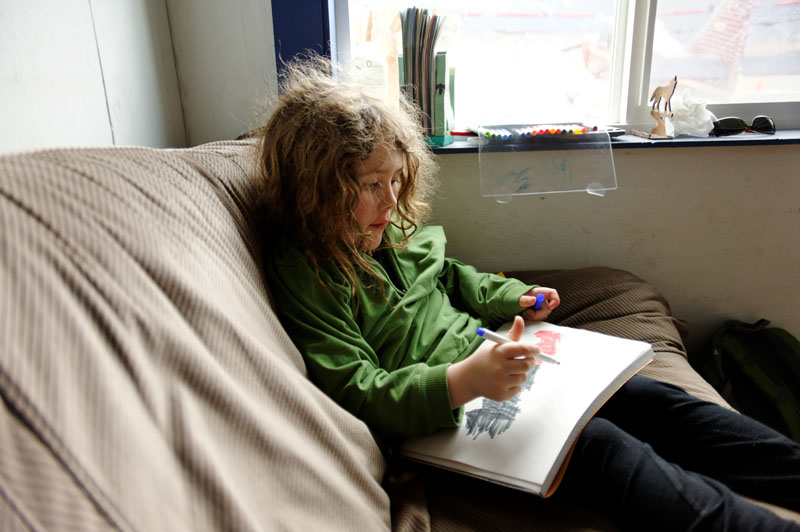
Coloring. |
|
|
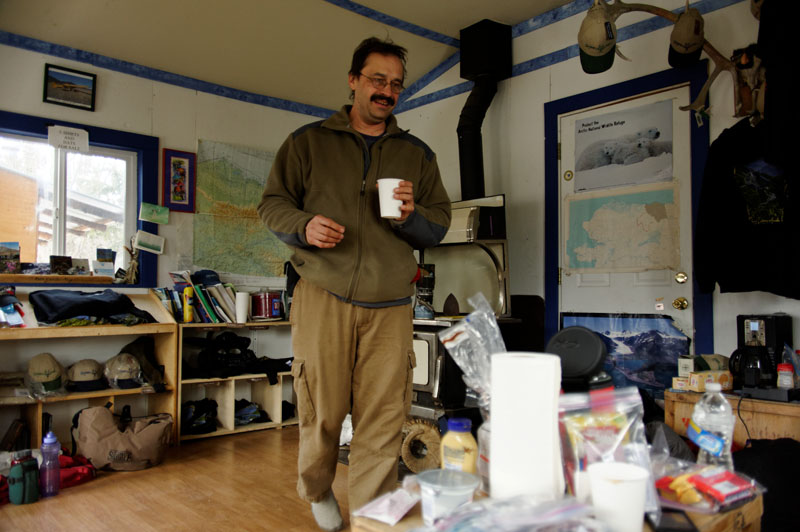
Milling about.
|
|
|
The next day weather was still
marginal everywhere, but from the satellite observations it looked
as though there might be a hole over our part of the mountains,
so we decided to go have a look. We loaded up and flew the low
passes that Dirk had flown hundreds of times, skirting the lower
clouds and occasional snow flurries. We flew over Arctic Village
where the valleys were clear, but as we approached the mountains
the clouds began stacking up. We poked our nose into the upper
Hulahula Valley, but the cloud bases were at about 6500' and not
quite high enough for us to get into the glacier. Danielle reported
that the weather in Coldfoot seemed to be closing in a bit, so
we decided to head back, listening to a podcast of Sunday's NPR
shows that Dirk had downloaded before heading out.
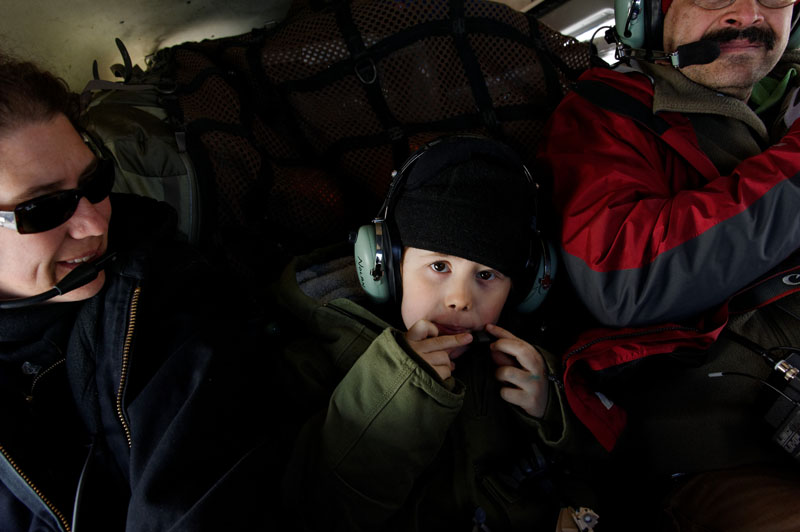 I guess I took one too many photos of Turner.
I guess I took one too many photos of Turner.
|
|
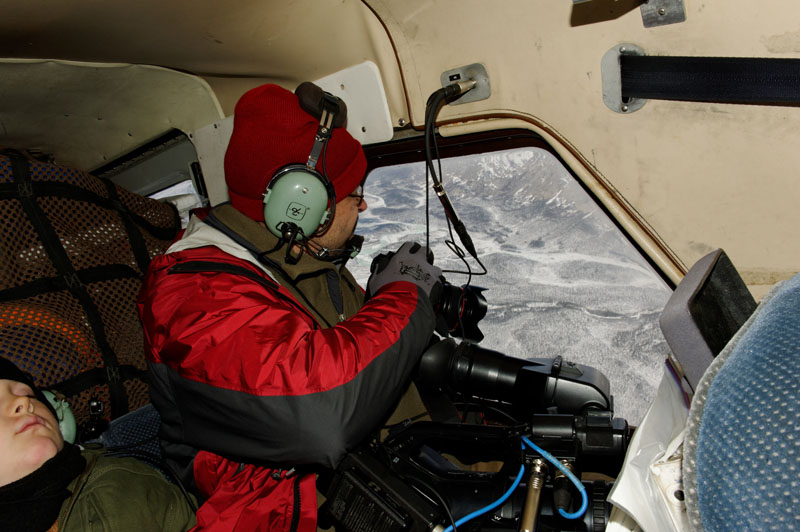
|
|
|
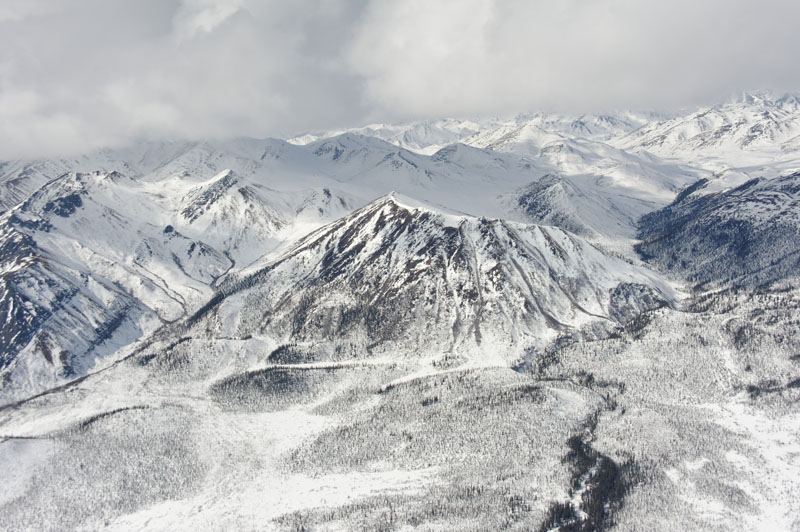
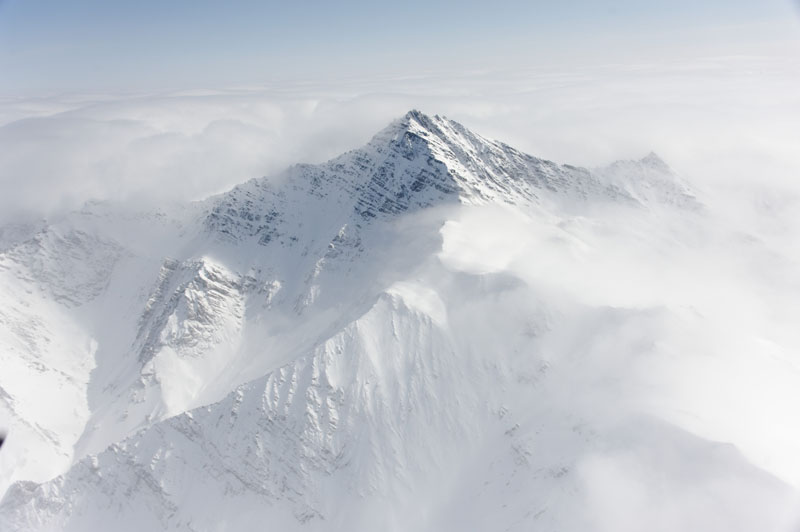
Not the greatest weather.
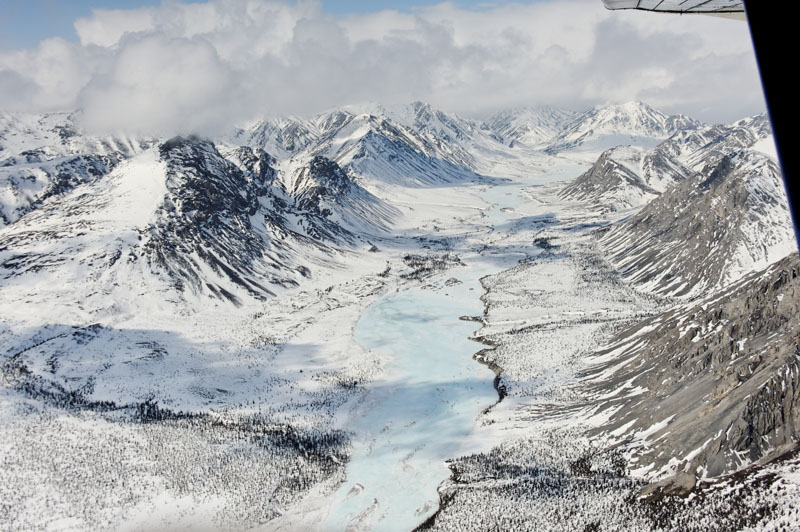
Aufeis.
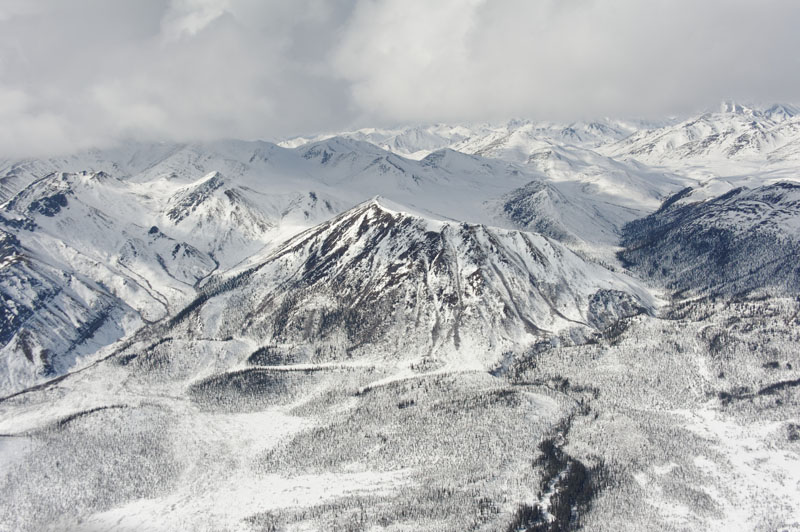 Back to the land of trees.
Back to the land of trees.
Here is where things started
to get interesting, as is normal. Dirk had essentially come up
to Coldfoot early to support our project, not really being sure
if we had funding or not, still had his second Beaver in pieces
in Fairbanks, and was itching to get back to finish putting it
back together so that he was prepared for the regular season which
would be starting up soon. The weather forecast at this point
was for continued marginal weather. So Dirk and his family loaded
up their truck and headed back to Fairbanks, leaving us to hold
down the fort here. The basic idea was that if the weather improved,
Dirk would drive back up and we would start our shuttling. The
issue here is that any breaks in the weather would have to last
at least 7 hours, as he would need that time to drive up, load
the plane and fly us out there. So it essentially looks like we're
here until we get some great weather. In the meantime, Keith is
headed to Alaska today from Kentucky. The plan is for him to find
his way to Deadhorse where Bob at 70 North would fly him in from
the North to meet us on the glacier. Of course we're not there
yet, and neither is Bob, who is planning to fly up today from
Anchorage. Given the state of things, it looks like we'll have
to put off the lake coring until later in the trip, and depending
on how things go it might be that Keith is able to fly in before
we do, which both complicates some aspects of safety and planning,
but would also give us a local weather observer to facilitate
the main gear put it. At this point we still have plenty of time
for everything we need to do, but clearly some rearranging of
priorities will have to take place.
04 May 11 Coldfoot
The weather never improved
yesterday. There was also a chilly wind, so we spent most of the
day in the office, watching videos, catching up on other work,
etc. After a nice dinner of burritos and lightening our margarita
load, we enjoyed some kite flying on the ramp. Turner tried my
stunt kite for the first time on his own and did great, probably
better than I did when I was learning as an adult. Dirk arrived
back from Fairbanks about then and we went to bed looking forward
to good weather.
We checked weather about 6AM
and found things looking up. Coldfoot was clear and sunny, as
was much of the interior. Arctic Village was also looking better
than it had been, but there were still clouds visible to the North.
In any case, we woke early and began getting packed and ready,
so that we would be ready to go in case had an opportunity. So
at 8AM, that's where we are now.

Kite flying!




Putting some extra english on it.
06 May 2011 McCall Glacier
It was a rocky start, but we're
on a roll now.
The weather that morning showed
continued signs of improvement. By 11AM we had word from Kaktovik
that they could see the mountains, so we decided to launch. We
were able to take a more direct route than the first attempt as
it was a bit clearer, but as we approached our site there seemed
to be a wall of cloud directly in front of us. We circled around
to the north over the Hulahula River, where we passed many valleys
filled with cloud and had an overcast above us. Until we were
nearly on top of McCall Glacier it was not clear that we were
going to make it in. Fortunately the glacier was free of fog and
we circled a bit to scope things out. From the air it looked like
there were a lot of drifts on the surface, but the light was pretty
flat so it was difficult to really tell. We located the air strip
and made our decent, but it wasn't until we were about to touch
down that it became clear that the drifts were significantly larger
than normal. We touched down gently, but as we sank in the soft
snow we quickly crashed through and over a drift, bounced, then
did the same again, before grinding to a halt, preventing us from
making a turn. Though it was a bit bouncy and rough, nothing shook
loose on the inside and we got out to start unloading.
As we were tossing out gear,
Dirk noticed that the right ski had lost its pressure and the
wheel was dragging after the second drift, causing us to slow
quickly. Memories of the last time we broke a ski on the glacier
quickly had me thinking of the many possible scenarios for what
might happen next, but it seemed that everything was still attached
firmly so we could attempt to take off. The next step was to turn
the plane around, which proved challenging. The extra drag caused
by the wheel prevented the plane from taxing to make the turn
even with full power taking the tail off the ground. So we hooked
a rope through the tie down eyelet of the right wing and pulled
while Dirk gave it full power, and this time we were able to swing
the plane around. Now the challenge was to pull the rope out from
eyelet before he took off and without dragging one us with him.
Fortunately this went smoothly, as once he made the turn he kept
full power on and headed down glacier busting through drifts,
trying to stay in a straight line despite the right tire dragging
heavily, something only possible by pilots who are one with their
aircraft. But after a few tense seconds (at least for us) he was
up in the air and we had arrived.
The weather on the glacier
was fine, though a little brisk. I headed over to the snow machine,
got it dug out, and it fired up on the first pull. I set a track
to camp and headed back to start shuttling loads and people. The
drifts were much bigger than normal everywhere. Normally when
it is windy here, there's not much falling snow, so there's not
much drifting. But clearly a storm had passed through recently
that coated the glacier and mountains with a healthy amount of
snow. We landed just after 2PM and by about 6PM had the cook tent
and a sleeping tent up. I headed back down to the glacier to get
the last of the gear and start scoping out a new skiway. The light
by then had gotten quite flat and even on the snowmachine I was
having trouble seeing the drifts. I scouted about quite a bit
but everything in the area was marginal. It was getting late by
now so I headed back and we ate a quick dinner before finishing
erecting the last of the tents and securing our stuff in case
the weather turned for the worse, which it showed signs of. By
about 11:30PM we were climbing into our sleeping bags, glad to
be out of the chilly air.
The next morning we awoke to
clear skies. I called in to Dirk to let him know and find out
how his skiis were holding up. Apparently the nitrogen recharge
held and he planned to head over in the afternoon. I also called
Mike and learned that Bob had made it to Deadhorse in the Helio
and Keith had also arrived. So after a little camp setup, I headed
back down to the glacier to find a good skiway. Even in the good
light it was tough to find something smooth and flat, but a bit
up from our normal spot towards the lower cirque I found about
900 feet of reasonably smooth area. The upper section was getting
fairly steep, so I was more concerned about them being able to
climb that in order to get a good take off run more than the landing
itself. Just as I was finishing up by about 3PM, I saw Bob circling
and gave him the rundown via the air-to-ground radio. He greased
the landing but was unable to taxi in his wheel skis, so we unloaded
Keith and his gear about midway on the strip. Turning him around
proved a challenge and after several different failed attempts,
we eventually used the snowmachine to pull on his tail wheel while
he put on full power to get sideways, at which point he was able
to power around the rest of the way on his own. Unfortunately
the turn wasnt tight enough to keep him on the groomed snow, so
he blasted his way through the drifts until he eventually became
airborne, again not something that the faint of heart or inexperienced
can accomplish.
By this time, Dirk was circling
overhead and the lower skiway was in shadow. He also greased the
landing but was able to keep his speed up on the snow and taxi
to the top of skiway and make a 180. This time he had come prepared
with a nitrogen tank to recharge his skis if needed, which fortunately
it was not. He was able to bring the rest of gear, so that at
this point we were more or less fully functional for the next
several weeks. Once unloaded, he was able to continue downhill
without assistance and hit Bob tracks and was quickly off the
ground, leaving the 5 five of us to begin the science we came
here to do.

The Helio on fixed-penetration skis.

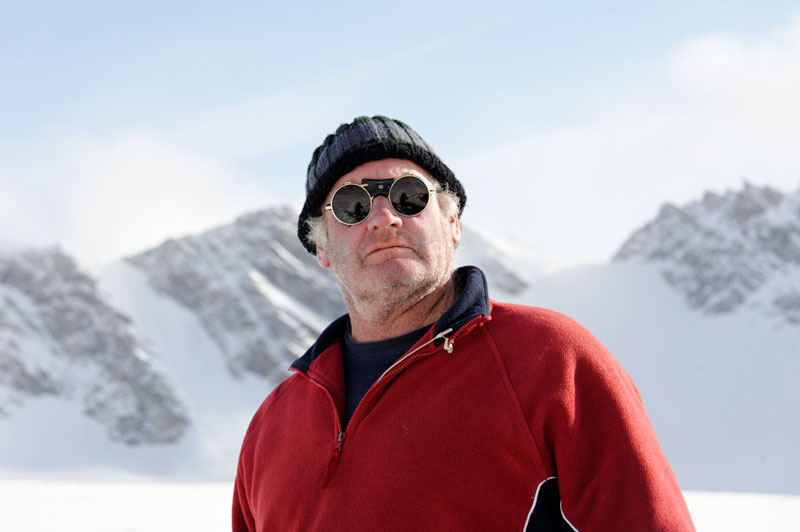
Apparently they let anyone on those things.

The Beaver was able to turn without assistance.

And holds a lot more.

Camp was snowy.

And the glacier had more drifts on it than usual.
|
|
|
It was a few hours by the time
I shuttled the loads up to camp and buttoned everything up before
dinner, but the sunshine and calm air made for a pleasant evening.
We enjoyed a nice spaghetti dinner and some wine, and Keith and
I had a chance to catch up a bit. Though I had seen him in on
his 2008 trip out here, we had only a few hours of overlap then.
So we chatted about our shared experiences at JIRP and the whereabouts
of mutual friends, before heading off to our tents in the late
night sunshine. The Nolans enjoyed another episode of the Clone
Wars before drifting off to sleep.
The next morning we awoke to
perfect weather again. Everyone was in good spirits and we spent
the morning getting camp up to full functionality and shuttling
our drilling gear to the upper cirque. The snow was hard and the
snowmachine prefers cold weather for power, so by noon we had
camp in good shape and were ready for a shake-down of the drilling
system.
We began by digging out the
freezer I built in 2008 and spreading out all of the gear on a
tarp. Keith has a tremendous amount of drilling experience, so
it was great to get his assessment of things and let him lead
the test coring. We set everything up next to where I had dumped
it off the sled and after drilling about 4 meters we had a pretty
good sense of everything we had forgotten at camp and were pretty
confident that we could begin the next day ready to start acquiring
our scientific cores. We quit by about 5PM in the hot afternoon
sun, bringing back a few hunks of core for the margaritas that
would accompany our Burrito Night. During dinner John downloaded
the many gigabytes of video he had shot during the day and I attempted
to connect to our weather station telemetry (unsuccessfully),
and we topped off the evening with fresh cupcakes, covered in
blueberries and whipped cream. Turner was especially happy about
the desert, getting most of it on his face to save for later.
By 8PM we were well fed and feeling sleepy, and by 9PM in our
tent watching another Clone War episode, making for a very civilized
work day. Tomorrow we hope for a good day of coring, hopefully
drilling at least the first of our 3 holes, if not the second
as well.
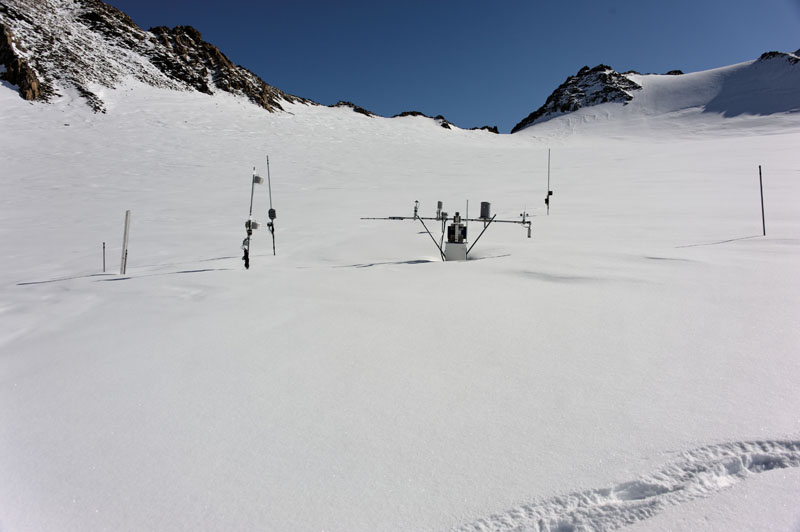
My weather station in the upper cirque. It's never really worked
well. I've replaced nearly everything, but I think I'll just have
to start from scratch with all new electronics.
|
|
|
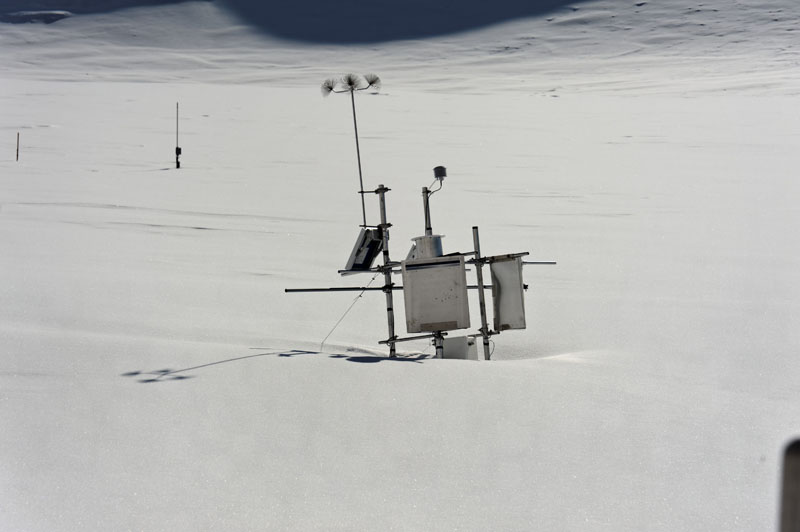
Andy's pollen station, before the upgrade.
|
|
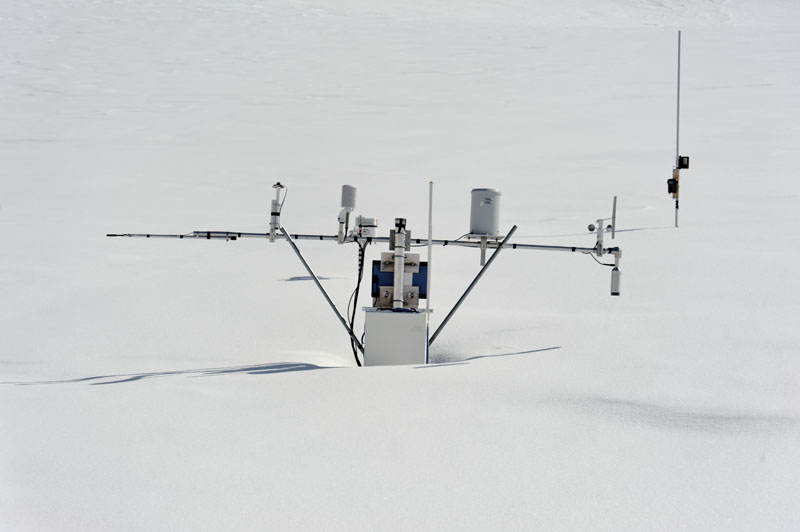
|
|
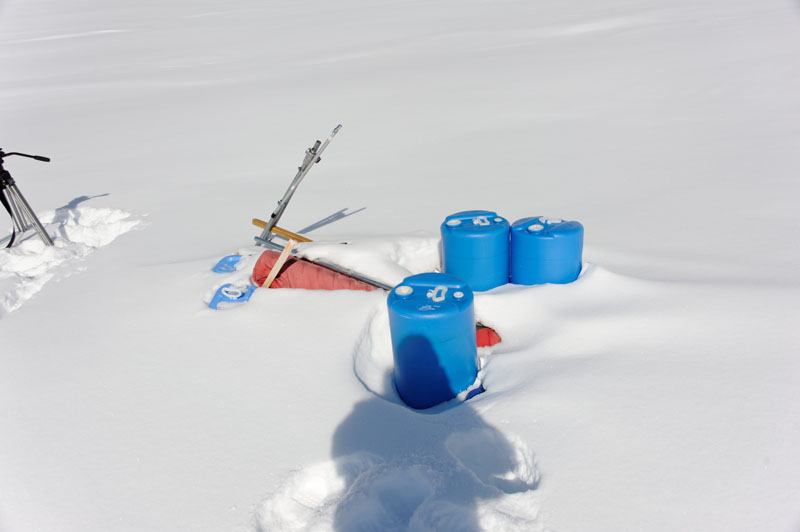
Those barrels are sitting on top of the freezer, which drops another
4 feet below the surface. |
|
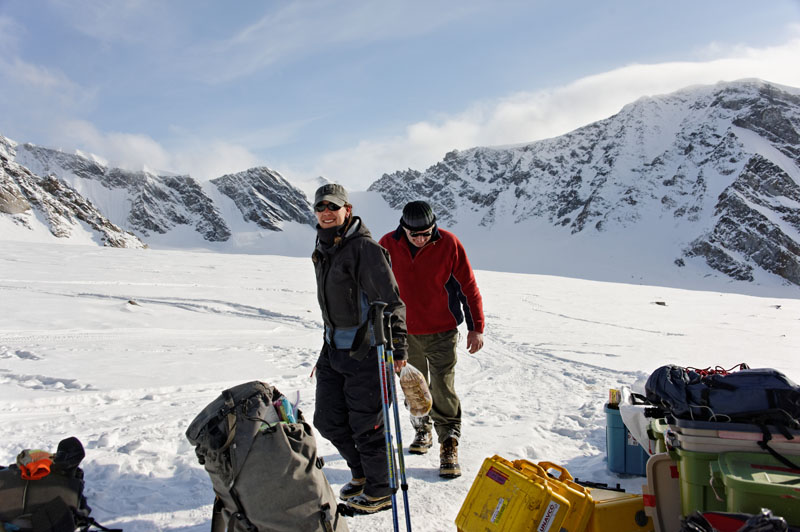
Going shopping at the local market. |
|
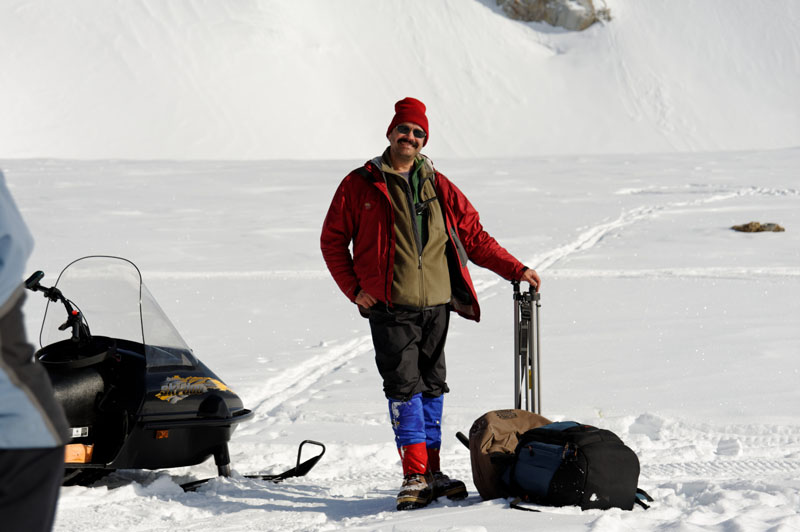 Have camera will travel.
Have camera will travel. |
|
|
12 May 11 McCall Glacier
Ice is nice and good for you.
The next day started early
but began late. We spontaneously began breakfast and preparations
for drilling and were headed down the hill not long after 9AM.
Unfortunately the snow machine was uncooperative. We loaded up
the sled with gear to head up the hill to begin our first real
day of drilling, but after only a few meters it died. By using
the primer, I was able to keep it running, but it would not continue
on the fuel pump alone. Fortunately I had a spare fuel pump, so
we tore the engine compartment apart to get at it and after copious
swearing were able to exchange the pump and put it all back together
again. Amazingly the machine was still functional afterwards and
actually ran. By the time we got to the upper cirque it was after
1PM, rather than 10AM, but we were still in good spirits having
accomplished something. The weather was perfect and we set up
on our first location and began drilling without further complications.
The drilling itself went smoothly, with Keith doing essentially
all of the drilling and me doing the logging and note taking.
Keith has tremendous experience with drilling, and even more tremendous
strength. We were using a hand auger, which consists of a core
barrel with cutting teeth attached to a T-handle which one twists
to dig deeper into the ice. We extracted about 50 cm at a time,
continuing down to about 5 meters. John filmed while we worked.
Compared to the day before, we were mostly silent, focusing on
the work. But before long we had achieved our goal, relocated
the equipment at our next site, and were back at camp at a very
civilized 6PM, enjoying a nice dinner before heading to bed around
9PM.
The next morning started largely
like the first. We got a reasonably early start down the hill,
but the snow machine was again uncooperative. At this point we
determined that all of the work 'fixing' it yesterday was probably
unnecessary, as it seemed clear at this point that the issue was
ice in the fuel lines. After getting it functional the day before,
it worked perfectly without issue. But by then it was warm and
sunny and likely all we had done was knock the ice loose and get
it past the carburetor. This time we couldnt even get the primer
to work, and after dissassembling it and barely reassemblying
it, we decide rather than mess with it further, we would just
walk up the hill, which was easy now since all of the equipment,
batteries, etc were already in place at the drilling site. It
had been a few years since I walked up there, and I felt refreshed
having done it. For the 5 years before we had the snow machine,
our only option was walking or skiing, including when we needed
to haul heavy loads up there. It only took half an hour, and by
11AM we were drilling again at our next location. This time we
drilled to 8 meters, again Keith doing the lions share of the
manual labor, apparently without breaking a sweat. Before starting,
I called Mike in Deadhorse. They were planning to go scope out
some lake drilling sites, so that by the time Andy and Mike arrived,
they would have sorted out the best locations for landing. Since
those lakes were close by, I asked if they could air drop us some
Heat, basically alcohol that binds with water in a fuel tank so
that it will pass more easily through the system without freezing.
Shortly after Kristin and Turner had walked up, we saw them flying
over. Unfortunately they did not see us, and I had forgotten to
bring the air-to-ground radio, so I pulled out my signal mirror.
I have carried this mirror for 20 years, but until now had never
used it to actually signal an airplane. Eventually they saw the
flash of light and headed our way, and once over our location
dropped our care package in the snow just down from us. The liquid
survived the drop, and we looked forward to testing it out. Without
a functional snow machine, transporting the ice cores to the air
strip would be an interesting chore. Given how dependent our work
has become on using the snow machine, I had planned to bring in
a second one this season, but due to our delays in the put-in
we decided not to fly it in until the ice cores would be flown
out. In any case, the drilling went well again and once we reached
our goal we moved to our final site, which was fortunately down
hill of the current one. Here we drilled another 7 meters, which
again went smoothly and we were packed and headed down hill by
5PM. We all walked to the crest of the hill above camp, where
John headed down first so he could film Turner and I sledding.
It was a pretty wild ride, as it was a small sled and my feet
hung over, kicking snow in our faces so that we were pretty much
blind. It had been perfect weather again, and the coating of snow
we ended up with quickly melted off and we once again enjoyed
eating dinner at a civilized hour and enjoying each others' company
without being totally exhausted. |
|
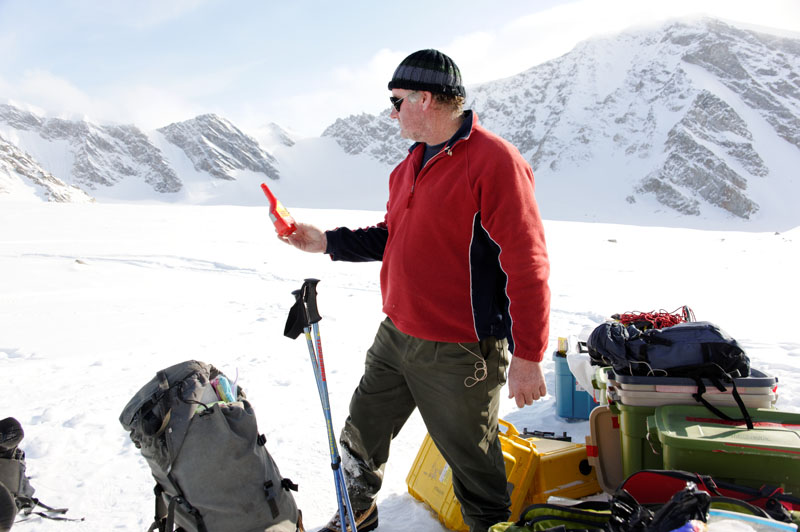
No Keith, that's for the snow macine, not lunch. |
|
|

Sword fights always end in hugs.
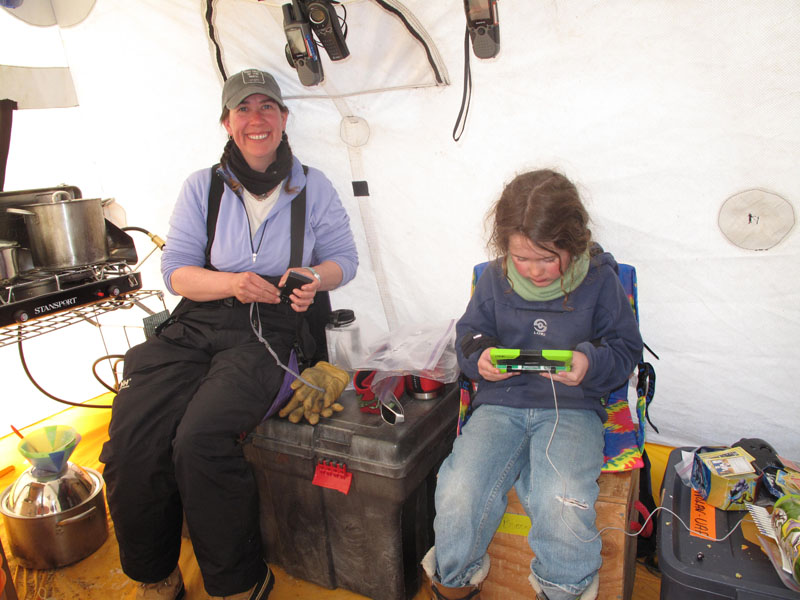
Or Nintendo.

The playpen has turned out to be one of the most useful pieces
of gear on the glacier.
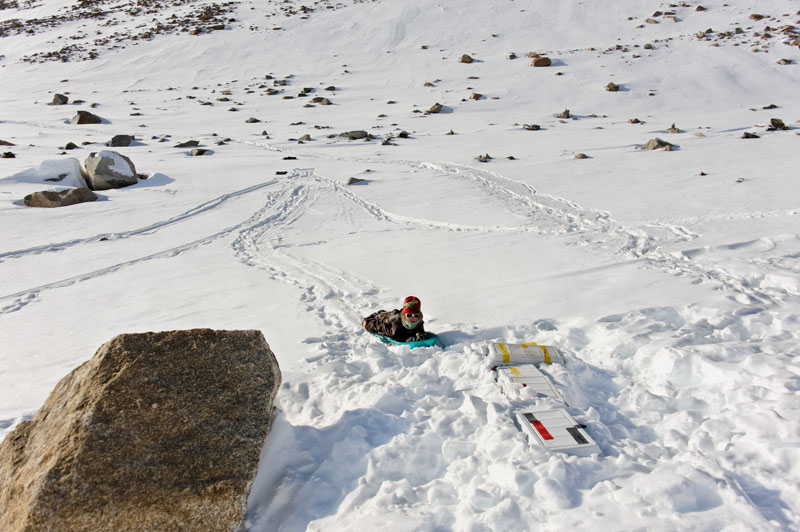
Sledding to the store.
|
|
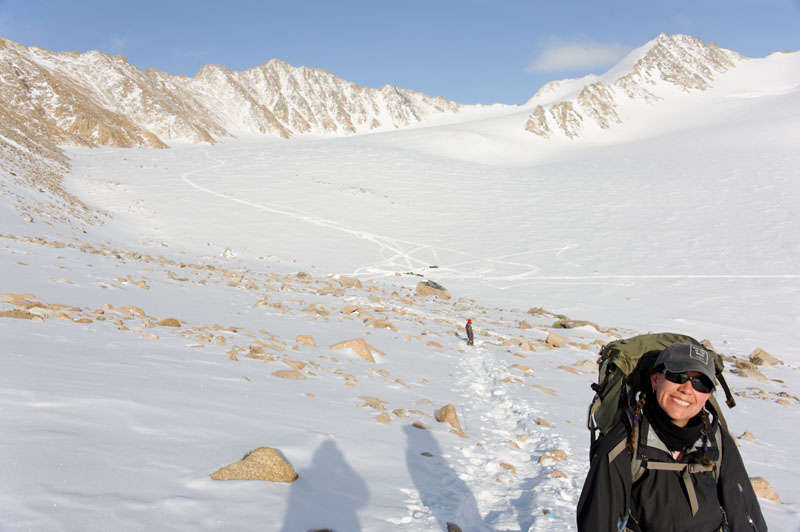 The commute back.
The commute back. |
|
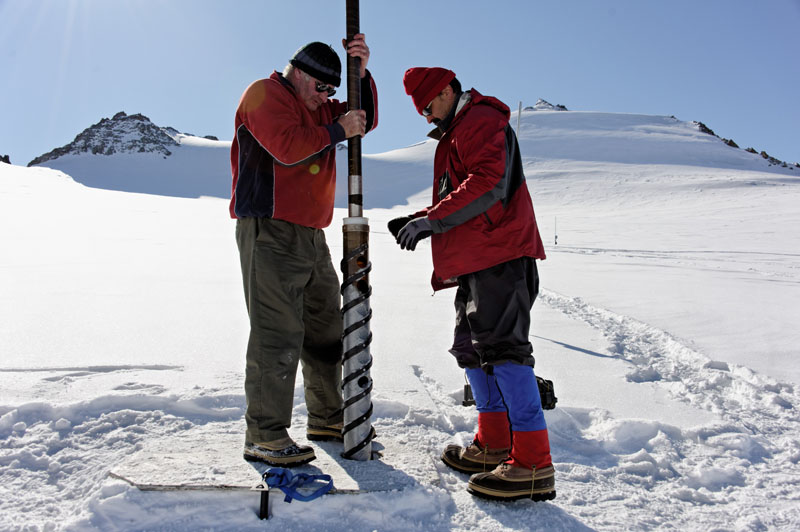
Keith showing John the ropes. |
|
|

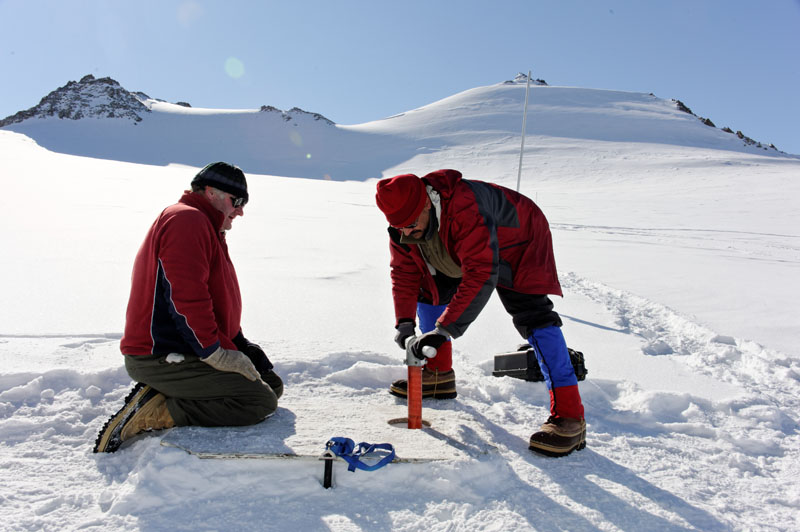
|
|
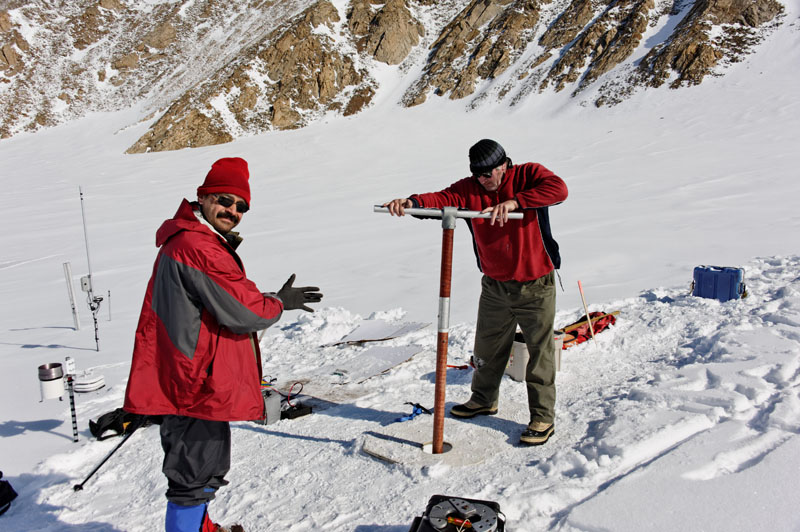 "Fun, but I think I'll go get my camera"
"Fun, but I think I'll go get my camera" |
|
|
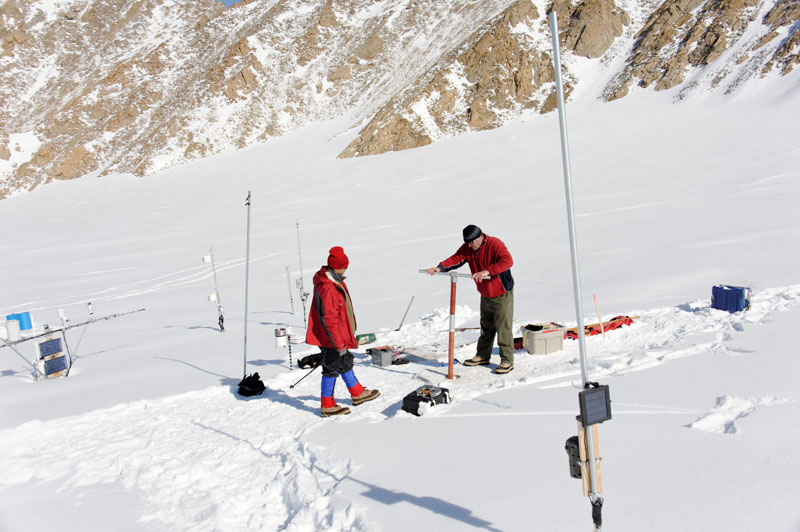
Mountain needs something to do anyway.
|
|
|
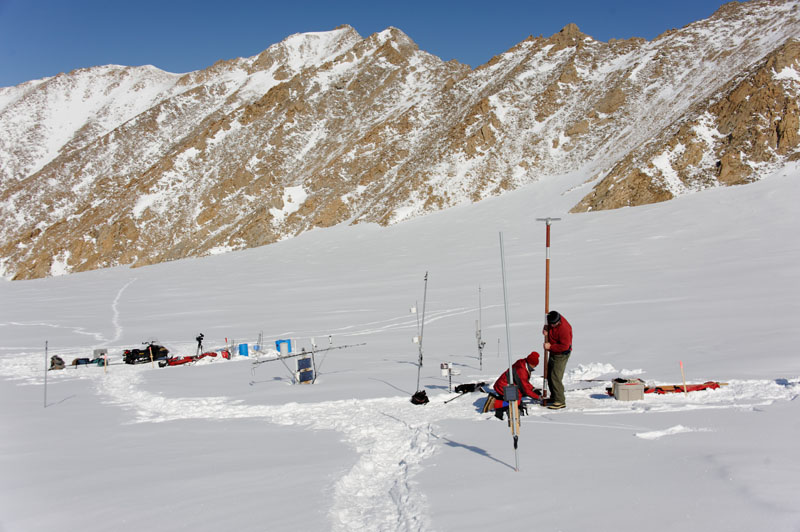
Pulling up the core barrel.

This is only about halfway down. Only Keith can lift something
this heavy.

I'm ready for the ice.

Here it comes.
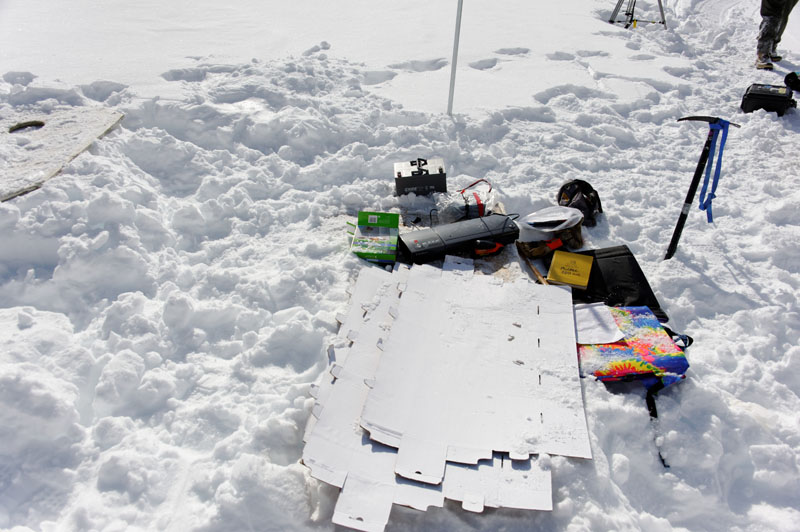
My makeshift processing table.

That's what we came here for.

If the core comes out in pieces, we have to make sure they fit
back together or note any loss.

It's really important to keep good notes on which piece of core
came from what depth.

Getting the bag ready. We use ones that come on rolls for vacuum
sealing food.

The most important thing when labelling cores is to make sure
you remember which way is up.

Our cores are mixtures of firn and ice, and the upper few
meters usually comes out in pieces. It's important to get the
pieces in the bag in the right order and orientation.

Once in the bag, we vaccuum seal them to keep the cores from moving.
The sealer is powered from a battery, which we keep charged with
a solar panel. Works pretty well.
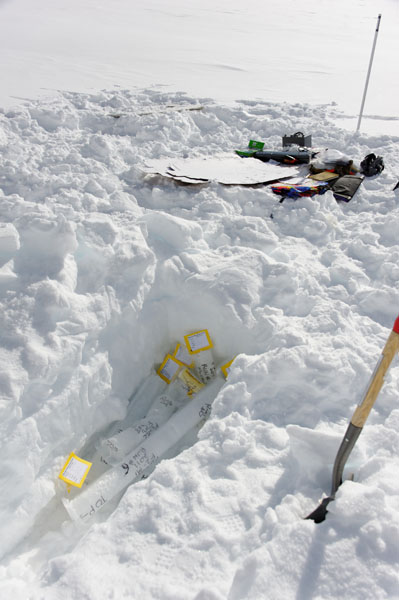
A temporary pit to keep extracted cores cold while drilling.

When we're done for the day, we load them on a sled and bring
them to the freezer.

The freezer no longer has any compressors attached to it. The
cold snow surrounding it is enough to keep them frozen, at least
for another few weeks.
The next morning I woke early
and went down to the snow machine first thing to see if it was
functional. I was prepared with a small stove to heat the engine
if necessary, but apparently the Heat we put into the tank the
night before did it's job and the machine fired right up, so I
came back up for some breakfast. Somewhere along the way I tweaked
my back to point where I could barely bend over. Fortunately copious
amounts of ibuprofen and midol had me doing the limbo again by
the time we setup to continue drilling. On this final hole, we
planned to drill to 20 meters. Here we want to acquire ice to
compare to our 2008 deep drilling, as the most recent 40 years
of record showed some pretty interesting atmospheric pollution
signals from Asia that we wanted to confirm was accurate. The
drilling went well, but we were having trouble pulling up the
core, at times having to re-lower the entire drill string several
times to recover the piece we had cored. This was exhausting and
demoralizing work, considering how heavy the drill was becoming
with 10-12 meters of extension rod. We tried installing core dogs
which help to prevent the core from slipping out the end as we
pulled it up, but this didnt seem to work so we took them off.
But then we still had the same problems, so we decided to put
them back on again. At this point I realized I had previously
pulled out dogs from our backup drill, which is a different design.
So after putting the correct ones on, and installing them correctly,
we had great recovery on our last few runs. We decided to call
it quits for the day on our 24th run, which got us to nearly 14
meters, and we all felt pretty good about the accomplishments.
Once again we finished at a civilized time without breaking our
backs or overworking our bodies. Pulling up the drill string at
this point takes at least two people, but a third helps in securing
it as we pull extensions off the top during extraction. Once again
I was amazed at Keith's strength, and enormously positive attitude.
A small army of guys like him could accomplish anything. Kristin
and Turner spent the afternoon assembling and labeling core boxes,
in between skiing, sledding, and playing badminton. They skied
back to camp, with us in front in the snow machine, letting John
film them. Turner has become a great skier, and even though roped
to Kristin, the line was always slack and his face always had
a smile on it. |
|
|
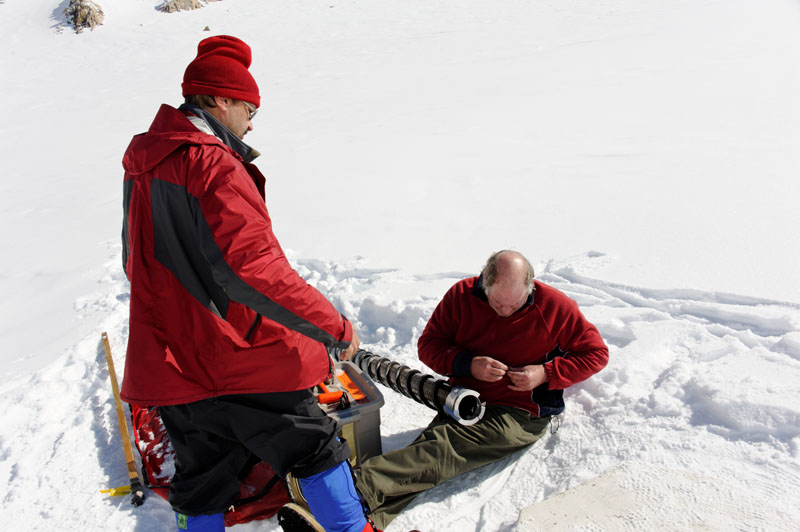
Improving the drill.
|
|
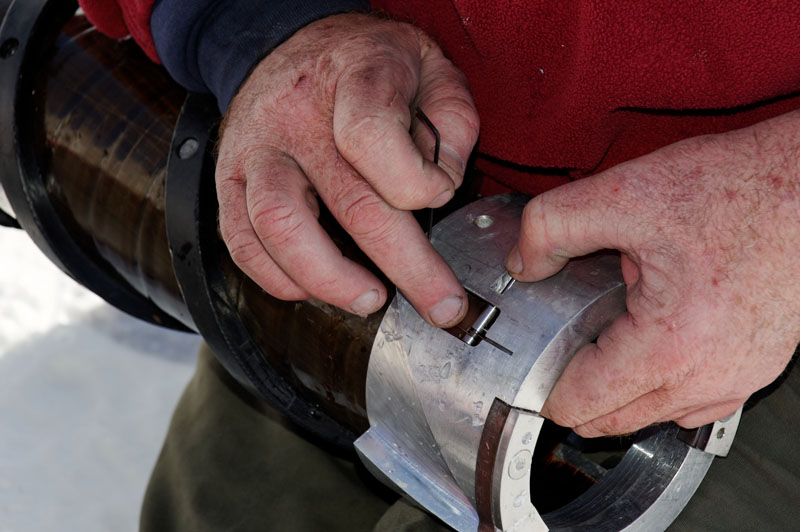
You wouldnt thing fingers so large could handle such small parts... |
|
|
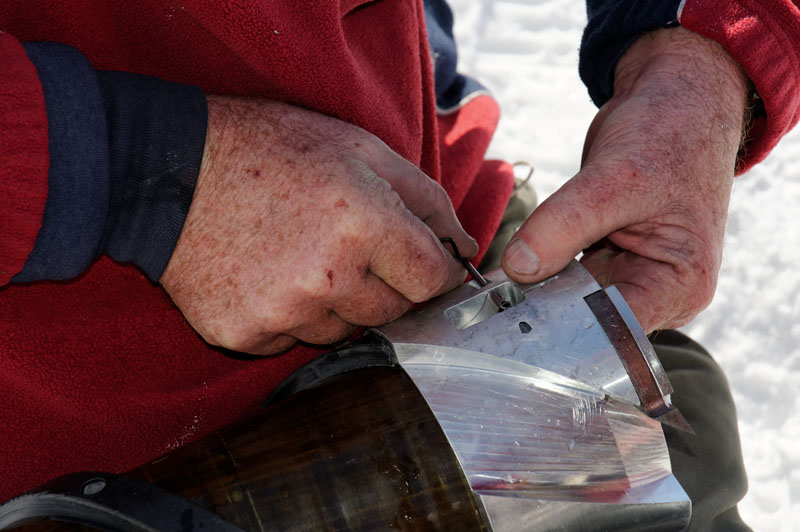
... then again I guess he's used to handling such small shafts...
The day was pretty much like
the past few. We had been pretty single minded so far on the trip,
focusing only on the drilling. Our goal with John had been to
make a small film on our drilling efforts, with him flying out
with the cores so that he could film them in final transport to
the freezer in Fairbanks. And given how perfect the weather had
been, clear and cool, it just made sense to knock it all out first
thing. The weather this morning had deteriorated, with low clouds
and occasional snow flurries. We got an early start again, and
by this time John had become a full time driller, setting up the
camera in time lapse mode as we descended down towards to 20m.
The three of us a made a good team, having fallen into a pattern
of roles that led to great efficiency. By about 2PM, we reached
20 meters and were glad of it. We spent the next three hours packaging
the cores into the core tubes and putting them to bed in the freezer.
It always surprises me how long that process takes, but it was
a fun effort with everyone chipping in for various assembly lines.
Turner was especially keen to help, which was especially comforting
to me. He really has a great attitude about it all, and though
at times he prefers to do different things than us, in general
he seems quite content to hang out with us and chip in, even though
he has little understanding of why we are doing the things we
do. The weather remained marginal throughout the day, with snow
flurries fairly continual. But it was not uncomfortable and again
by about 5PM we had everything packaged up and we heading down
the hill for another civilized evening, feeling somewhat proud
not only that we had finished all of the drilling without getting
the drill stuck but had done it all with using a generator, trying
our best to remain consistent with the values of this wilderness
area.
That night I talked with Dirk
and we made a plan that he would come in the day after tomorrow
to bring the remainder of our gear and pull out the ice cores
and John. So far it had been a very pleasant and productive trip.
Keith not only was a pleasure to work with (since he did most
of the work) but also a pleasure to trade insults with. In the
real world, most people overhearing our conversations would probably
assume that we were about to pull out guns and start shooting,
but as it was with my friends from college, insults were really
used in the opposite way, signifying a higher form of mutual respect
than politely saying please and thank you all the time. I think
in a way too it lowers the bar for taking offense, so when you
correct someone or suggest doing it a different way it's actually
a step up from normal conversation. I had forgotten how much I
missed that. Similarly John fit right in with the group, and though
he often was hidden behind a camera, he was always ready to quip
back or lend a hand in whatever was happening. Turner seemed to
take it all in stride and though he politely corrected my use
of four letter words a few times, he understood it was only joking.
And he has been great at getting involved, as well as keeping
himself occupied, though always eager to share what he's accomplished. |
|
|
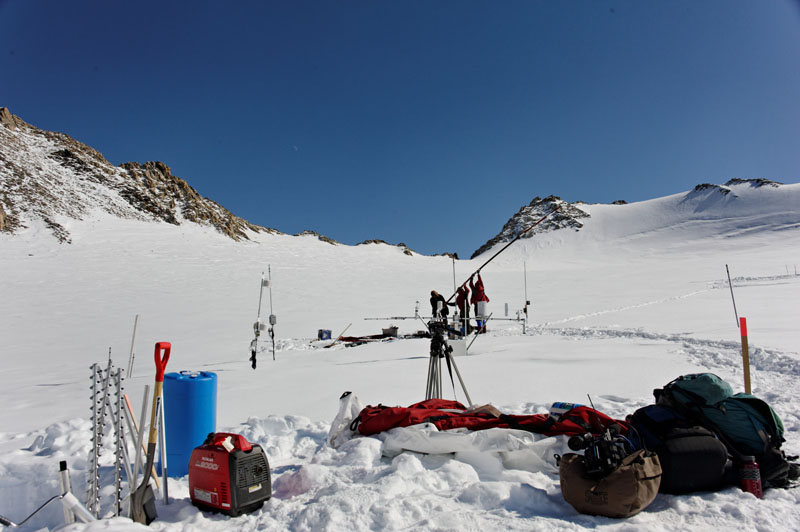
I doubt anyone will make a postage stamp for us, but that's ok.
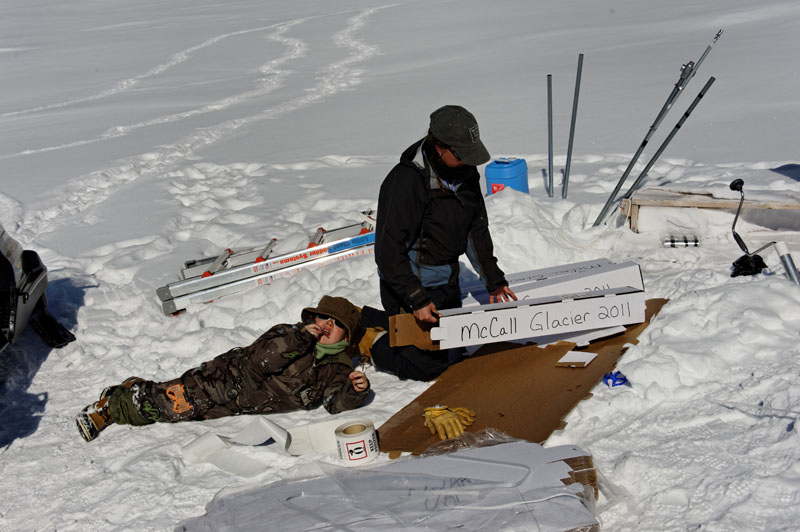
Snack break.
|
|
|

Labelling boxes.
|
|
|
|
|
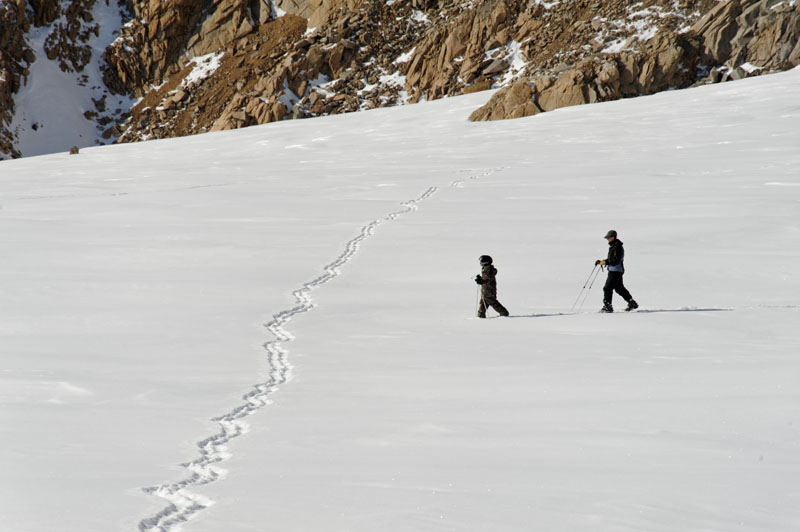
Ski break. |
|
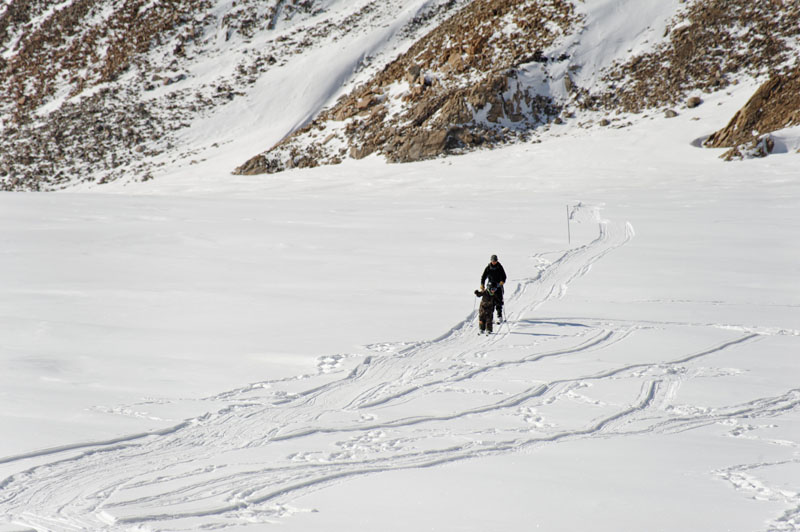
|
|
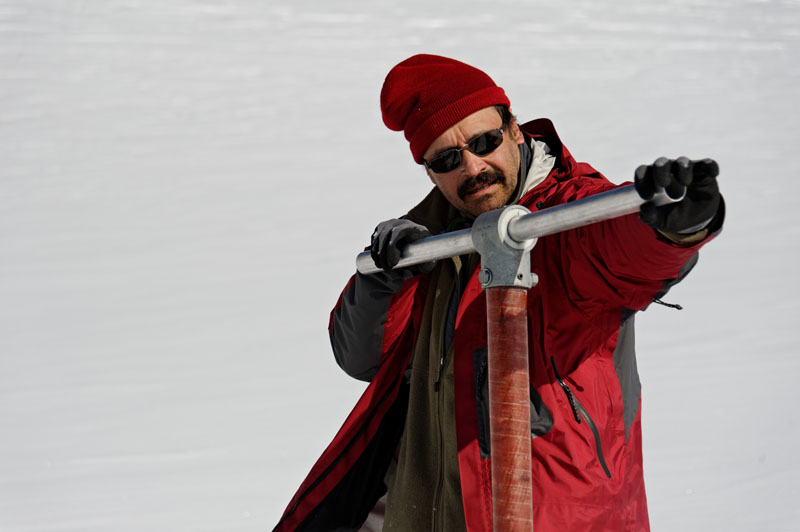
John was an old hand at drilling by the end of the trip. |
|
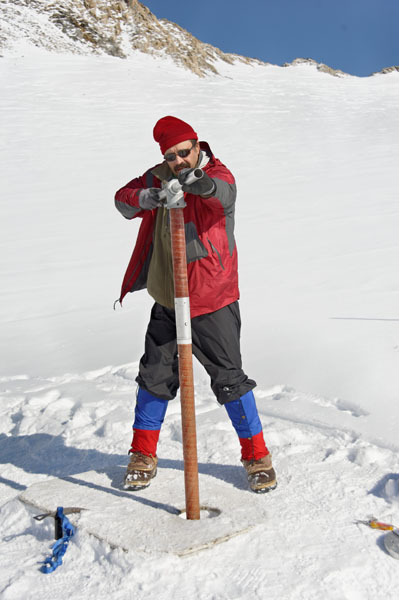
|
|
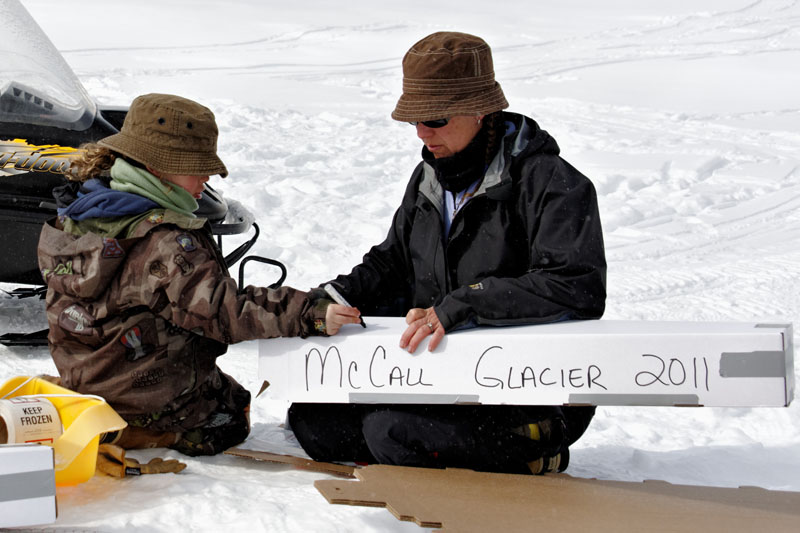
|
|
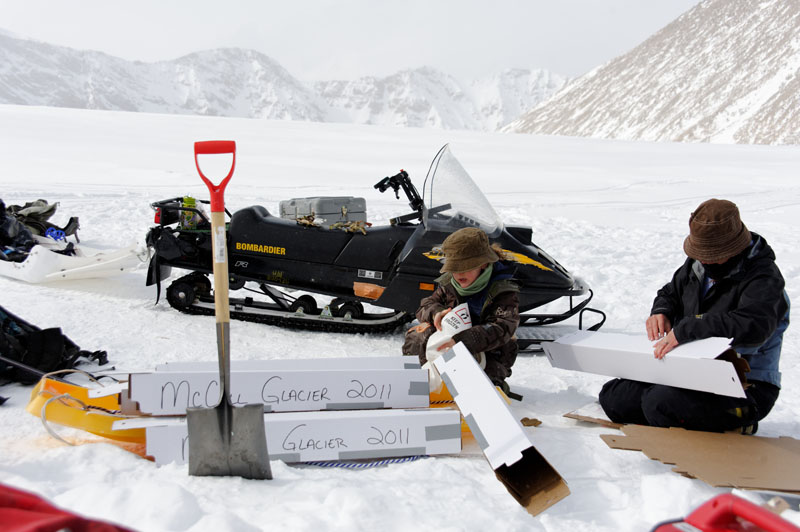
|
|
|
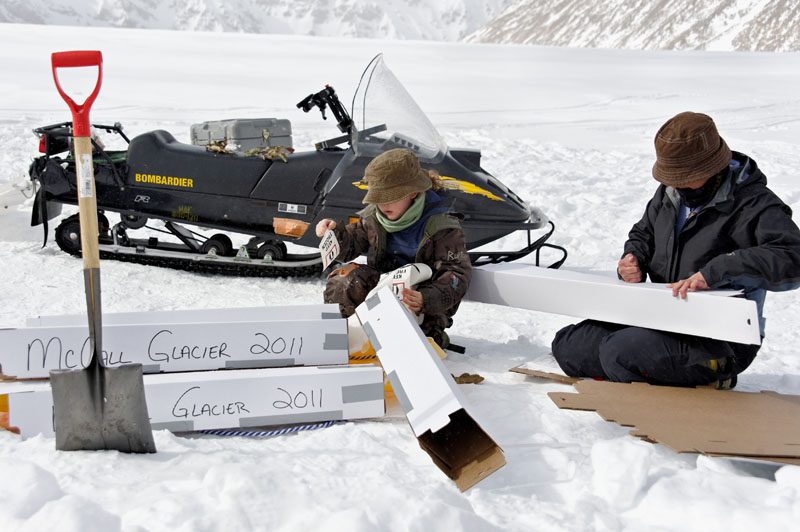

No more extension tubes left, I guess we're nearly done!


Now all that's left is pulling the damn thing out.
|
|
|
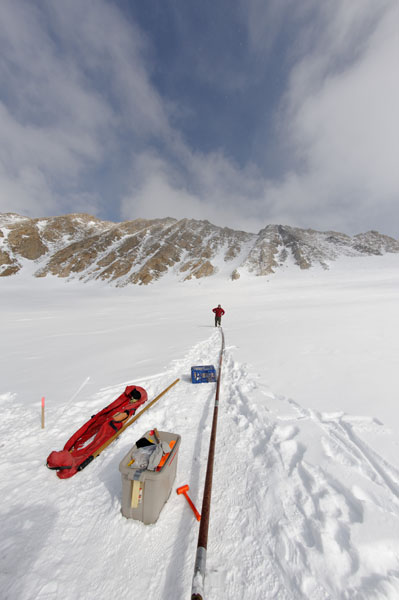
Whew!

A nice place to visit, but we forgot our sleeping bags.
We all slept in a bit the next
morning, having worked very steadily the past week on the coring.
I think I've gotten more consistent full night sleeps here than
I have for months at home, and I think the others feel similarly.
It still never feels like enough, but it is refreshing nonetheless.
The weather was once again perfect, and we made a plan to move
the ice cores down to the skiway, so that if Dirk came in early
the next morning we would be ready for him without too much scrambling.
So I dropped off Keith at the head of the runway where he began
digging a pit to put the cores into. The snow here was about a
meter deep, and the top of the ice about -10C, so it was plenty
cold to keep them frozen for a few days if needed. Then I grabbed
John and we headed up to the freezer to begin loading cores onto
the sled. We had 41 core boxes in total, largely thanks to Kristin's
efficient combining of small and large pieces to leave little
open space in the boxes. We loaded 20 cores in the sled, threw
the brake rope under it, and I headed downhill to bring them to
Keith. Along the way I picked up the scale at our cache on the
ice below camp so that we could get a total weight. On the way
down, Kristin radio'd me to say that Bob was flying overhead.
By the time I got to the skiway he had landed and Andy and Mike
were walking around, probably thinking they were a long way from
Mississippi. They had landed in Deadhorse the morning before and
tried to go out to sample lake sediments for pollen samples, but
had to turn around because of too many polar bears. This morning
the weather on the coastal plain was not great, with low ceilings
and flat light, so they only got to one lake before deciding the
weather was too sketchy and decided to come to the glacier. So
after turning Bob around and sending him off for another load,
I left these three behind to weigh and cache the cores while I
went for another load. In the meantime, John had walked down and
was filming some of the action.
Kristin and Turner had spent
this time organizing and sorting food and gear at our cache below
camp, and Turner was now very excited that Andy was on the glacier.
He was hiding behind his favorite rock to surprise him, but I
explained that it might be a few hours before he was back at camp.
So on my way down with the next load of cores, I put him in the
back seat to hold on to the 41st core which didnt fit well in
the sled. The crew on the skiway was making great progress, so
I left Turner with them while I got one last load of drilling
gear that we no longer needed to send out with Bob. By the time
I returned 30 minutes later, Turner had made a new best friend
in Mike, after he learned that Mike had played Mario Brothers
as a kid. Not too much later, Bob returned in the Helio with the
remaining gear, and after turning him around manually again, we
headed back up the hill to reconsolidate. By the time we were
back in camp it was after 5PM, so it wasnt the most productive
day in terms of science, but still a lot was accomplished. For
me, it felt like the first day of the trip, since I had barely
unpacked or even thought about my other science goals for the
trip. In any case, that night we toasted our success in getting
everyone to the glacier, and if things went as planned this would
be the only night with seven of us in camp as John was due to
leave in the morning.
Throughout the trip, John and
I had a number of conversations about film making and art and
photography, as well as possibilities for films here and elsewhere
in the Arctic. John had spent a few years in Alaska when younger
and been back and forth a number of times, and has a lot of experience
mountaineering and backpacking. I had the impression that though
he enjoys the film making work he is doing now, working in remote
areas like ours was a refreshing change. It remains to be seen
what might happen with what he's shot here, but it seems like
there this might be a useful way to reach a broader audience about
the work we do here and how it might relate to them.
The next morning we woke up
to perfect weather once again, and having talked to Dirk learned
that it was also great in Coldfoot, so we planned to see him about
10:30. John was awake early, needing to pack and consolidate his
gear. Mike was also up early, tending the stove and melting snow.
The other drifted in and by about 9 AM we were were shuttling
loads down to the bottom of the hill and by about 10:45 the entire
group was assembled at the skiway awaiting Dirk's arrival. Before
long he crossed the ridge into our valley and came in to land
at our bumpy strip. The Beaver was stuffed with miscellaneous
gear, including a backup snow machine I had bought earlier in
the winter. Once offloaded, he tried to reposition himself at
the top of the runway before we reloaded, but in the end took
off and landed again, getting a little assistance to in the end
from Keith and I to get him aligned. Then we began the now annual
assembly line to load him up with ice cores. Next came John's
gear and John himself, and soon it was just the six of us, ready
to start the next phase of the trip. |
|
|
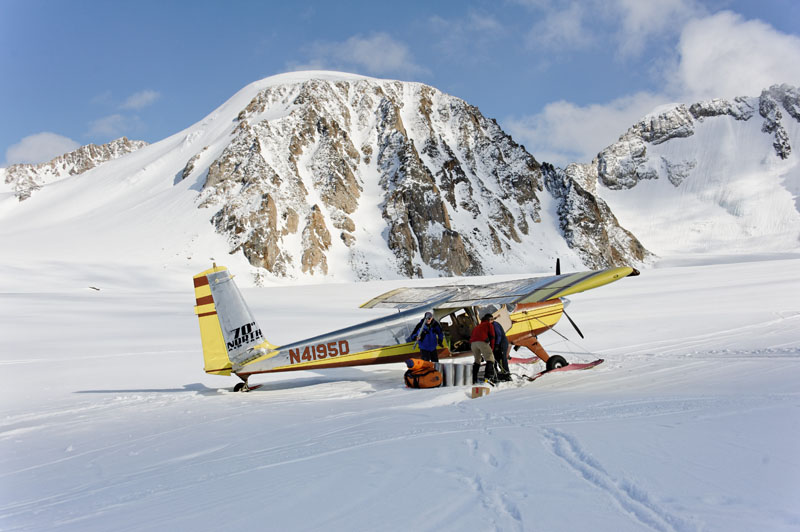

"We're not in Kansas any more"

One of our steam drills.

The backup snowmachine came in handy later in the trip.

One last Nolan family shot for John.

And then there were six of us.
See
a view clips of the video John shot, arranged by Tom Veltre.
This is not a finished or polished piece, just gives a flavor
of things to come. |
|
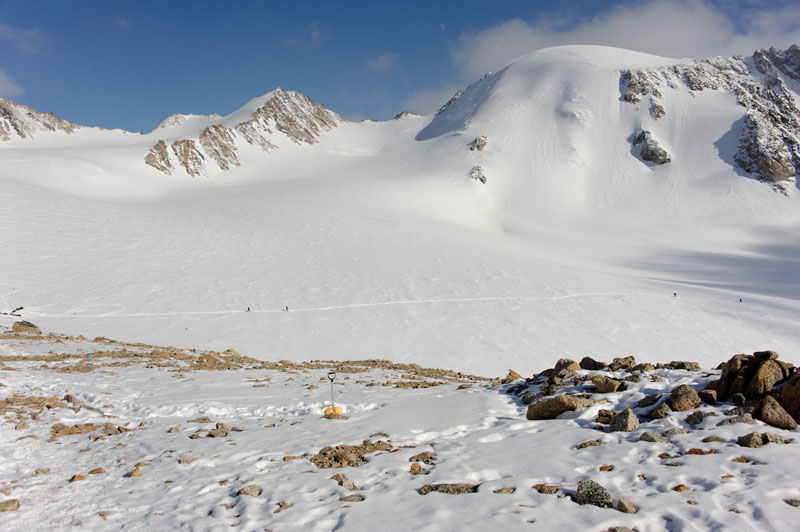
The ants returning to the nest after a long day of foraging. |
|
|
By now it was lunch time, so
we got some food and made a plan for the rest of the day. Keith
wanted to hike up to Ahab to get the view, considering there was
a not a cloud in the sky. Kristin and Turner stayed in camp to
rearrange the cook tent and sort some gear. Andy, Mike and I headed
up to the upper cirque to work on dataloggers. Andy has plans
to revamp his pollen station, adding several more traps and raise
it up above the accumulating snow. I was eager to see how my 8
various dataloggers in the upper cirque had fared over the winter.
Most seemed to survive OK, but there were a few sensor failures
and one of the dataloggers seems to have gotten fried, but all
about par for the course. Andy and Mike dug out their station
and found the datalogger and sensors functional, and the traps
filled with pollen. We spoke with Keith over the walkie-talkies,
and he was enjoying the view, being able to see all the way to
the Arctic Ocean. He also confirmed that the reason why this station
was no longer reporting via telemetry was that the battery was
dead and split open. Fortunately I had brought in new batteries
for all of the stations this year, though unfortunately someone
is going to have to lug one up the hill. In any case, by about
6:30PM we were all back at camp and ready to start dinner. Turner
decided tonight was spaghetti and meatball night, followed by
brownies for desert. I called it an early evening so I could catch
up on these notes, and the Nolans ended the evening with the next
chapter in Turner's dinosaur DVD, this time about dinosaurs in
North America.
14 May 11 McCall Glacier
The weather changed the next
day. The wind picked up substantially over night, and it seemed
like we would get some storms. The sky remained clear though,
and the temperature rose. It was a sluggish morning, but we were
out on the glacier by about 10:30PM. I headed down glacier to
download dataloggers and check the state of things. There was
almost no wind there, but clouds began appearing and it was clear
that they were moving fast. Kristin and Turner remained at camp,
and reported that it was consistently windy there. The others
went to the upper cirque to revamp Andy's pollen trap station.
Here he wanted to install several additional traps to compare
designs, as well as raise up the instruments so they would not
get buried next winter.
The downloading went well.
It was nice to get out on my own, the first time on this trip.
Most of the dataloggers were functional and by early afternoon
I had them all downloaded and working with fresh batteries. The
snow was noticeably getting softer through the day. As is usual,
the lower glacier had a lot of bare ice exposed, making snow machining
a challenge, though I worried a bit that a few days of melt would
increase this challenge significantly. The noise of rockfall was
continual, and occasionally I would catch sight of one. It was
nice working independently. With the second snowmachine, I was
relieved of being group chauffeur, which increased overall productivity
substantially. I heard on the radio Keith heading back to camp
for supplies, something that would take several hours on foot
but only several minutes by machine. Once finished with the downloading,
I installed an anemometer and a combined air temperature and relative
humidity sensor on our camera station at the skiway, so that in
the future if this is the only station functional then we would
still be able to get the most important information necessary
for landing logistics. I also installed a new battery, a better
one that last year, so hopefully the station will survive longer
this time. It's not clear to me why the battery failed over the
winter, but I suspect there is a hidden load on the camera. In
any case, I left the station up and running, confirming that it
was acquiring data and transmitting to Kaktovik via a portable
radio unit.
Once finished with all this,
I headed up to the upper cirque to check on pollen station progress.
A lot of work had been completed, with several new traps installed
and much of the station raised. Andy was waiting on final modifications
until May 15, when the automated system was due to open the trap
remaining from the original configuration. He had a lot of bad
luck with the automation the past few years, but it seems now
the bugs are worked out as over the past year they have been responding
correctly. He now has at least a year of airborne pollen collection,
divided into winter and summer traps. The general idea is to assess
the types and amount of seasonal airborne pollen, and then compare
this with what gets trapped in the snow, such that ultimately
we can figure out whether or how much pollen is transported along
with surface meltwater into the subsurface. This information will
give us a better idea of how the ice core may have been affected
by similar processes in the past. By the time I got there, they
were nearly finished for the day and we all headed back to camp
by about 5PM.
Once back at camp, it was clear
that the windiest weather had eased up a bit, so Mike decided
to have a quick run up to our Ahab weather station on the ridge
behind camp. However, I loaded him down with a 70 pound battery
to replace the failed one in the station. This slowed him down
considerably. After an hour or more of slogging it up the hill,
he ditched it and headed back, fortunately getting it nearly 3/4s
of the way up. The weather at camp remained nice, and significantly
warmer than we had previously experienced in the trip. While waiting
for Mike to return, we had broken into the booze and several tins
of canned fish for hors d'oevres. Once back, we had a
nice dinner of Thai peanut chicken along with a movie. For desert,
it was hot chocolate and brownies. By the time the movie was over,
I was headed out the door to relieve my stomach of its highly-mixed
contents, some of which exited through my nose. So it was an early
night after that for me.
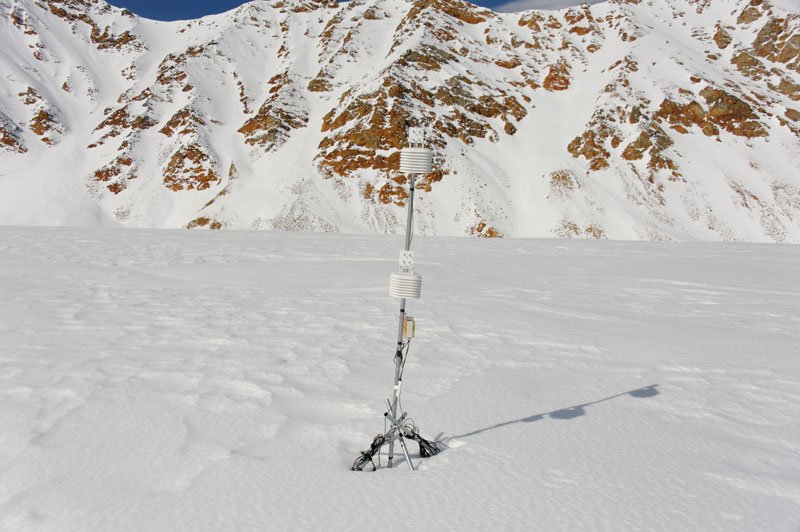
One of our shallow thermistor strings on the lower glacier.
|
|
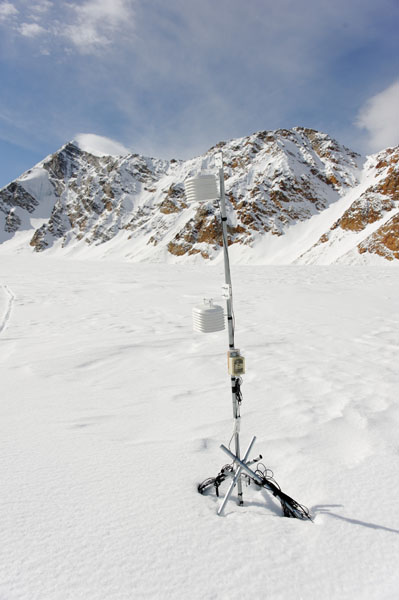
|
|
|
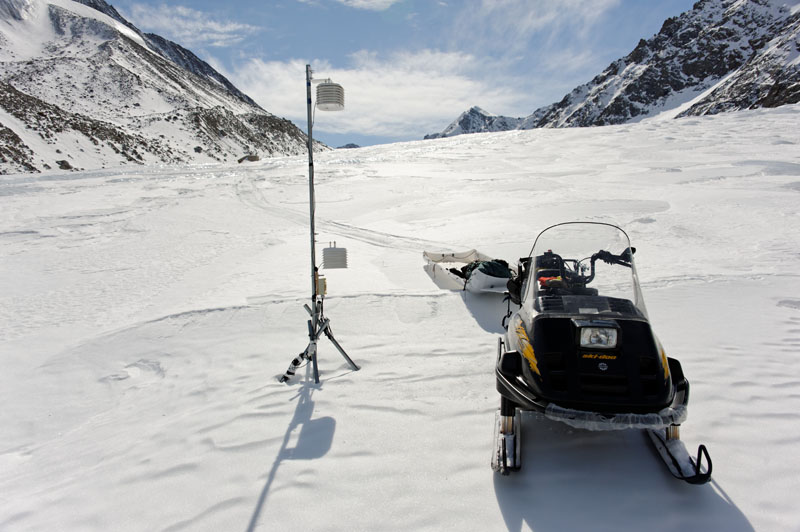
This site has been the most problematic, I think because the
highest winds on the glacier occur right here.
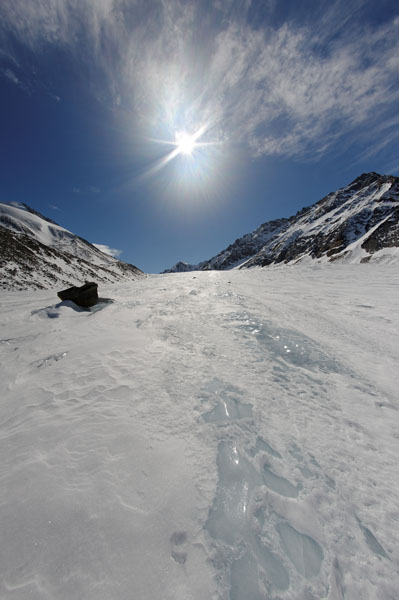
This is the most treacherous part of the glacier to snow machine
on, because the ice under the thin snow is super slick.
|
|
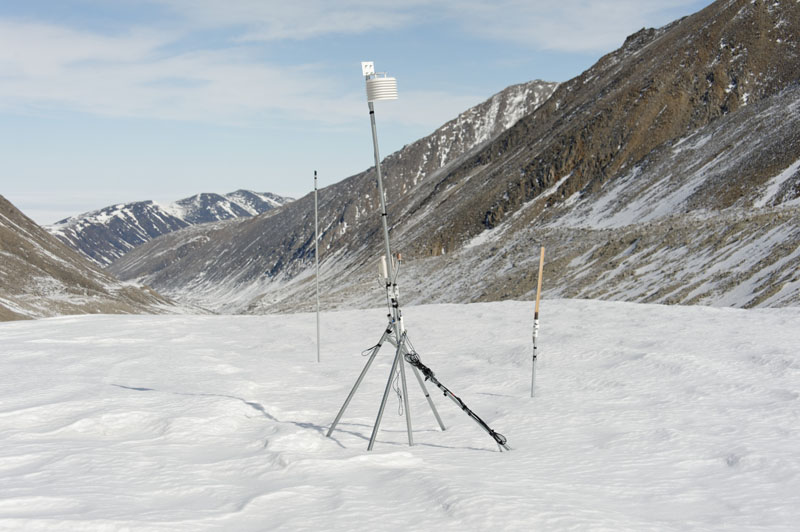
The lowermost station and mass balance poles. The end of the glacier
is just over that edge. |
|
|
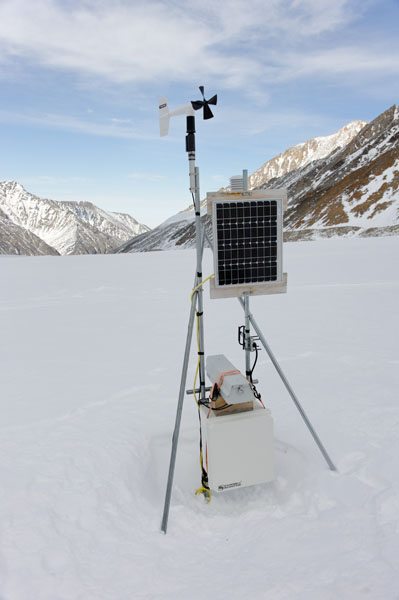
The camera station, now with anemometer.

Digging out the pollen station.

Adding new traps.

Wasting my tape ;)...

Would you buy a used weather station from these guys?

If so, better not miss a payment fuckhead...
The winds had picked up again
overnight, but by morning it was another calm, clear beautiful
day, this time much warmer. Keith and I decided to head up to
Ahab, picking up the battery on the way and hopefully reviving
the station. We split the job of carrying the battery up to the
station, with my contribution being the last few feet from his
pack to the logger box. I asked him about halfway up whether he
wanted to switch carrying the battery up, after watching him fall
with a mouthful of curses several times, and he responded by saying
something to effect of "Ah, no, a fat old fuckin' white guy
like me can use the exercise. Though if fuck-knuckle hadnt have
carried it up so far yesterday, it might be dinner time before
I got it up here." He's 15 years older than me, but I would
feel lucky if I had half his strength in the 15 years. For that
matter I would be happy to have half his strength now...
In any case, the station sprang
to life immediately once the new battery was installed, with all
the sensors functional. Fortunately I had installed a small backup
logger last August, and this remained functional throughout the
winter. Some minor differences are likely between the two types
of sensors, but there is enough overlap between the records that
we will be able to assess this and I think we can claim that we
still have a continuous air temperature record here. We chatted
a bit about life and science on the way downhill, and then split
up as I wanted to take some panoramas. I hung out on a large rock
in the warm sunshine for a while as I ate my lunch and smoked
my pipe, and soon enough the complete cloud layer that had rolled
in an hour before was gone and I set up on the outcrop I had eyeballed
earlier. From here I could see the stations in the upper cirque
and the lower cirque, as well as a bit downglacier. The weather
held for the next hour or so while I acquired about 400 photos
that I will stitch together into a single mosaic back in Fairbanks.
Hopefully it all worked out, but it's tough to tell until I actually
try it. It was about 4PM by the time I got back to camp. Kristin
and Turner had gone down to the cache on the glacier to sort some
gear and bring back some new food, alternating with various games.
It was a treat to watch them play, and a pleasure to see Turner
enjoying himself so much. About this time Andy and Mike returned
from a day of setting up new pollen traps in the lower cirque
and near JJMC. By 5PM or so we were all back in camp. This time
fuck-knuckle was determined to see the view from the top, but
no amount of cajoling would convince him to take the frame pack
up so that he could take the old battery down. We still have a
week to work on him though...
We laid off the canned fish
waiting for him to return, but it was only an hour or so before
he returned, at which point we enjoyed a nice dinner of mashed
potatos and bratwurst, followed by cupcakes covered with semi-frozen
blueberries. Dinner conversations often have a thread of how people
can claim climate change is not real and what can be done to educate
people. Often the conclusion is that people cant be educated if
they dont want to be, but today we discussed what goes through
the brains of the leaders of these movements. Keith wanted to
put them to work in field camps to see how long it would take
them to permanently succumb, or at least challenge them to make
their own field measurements that would counter nearly all of
the scientific evidence being gathered by the scientific community,
rather than sitting in their air conditioned offices making up
bullshit. I thought that would make a great documentary, comparing
where and how these guys worked compared to where and how we work,
and let the public decide who really has the motivation to make
stuff up. |
|
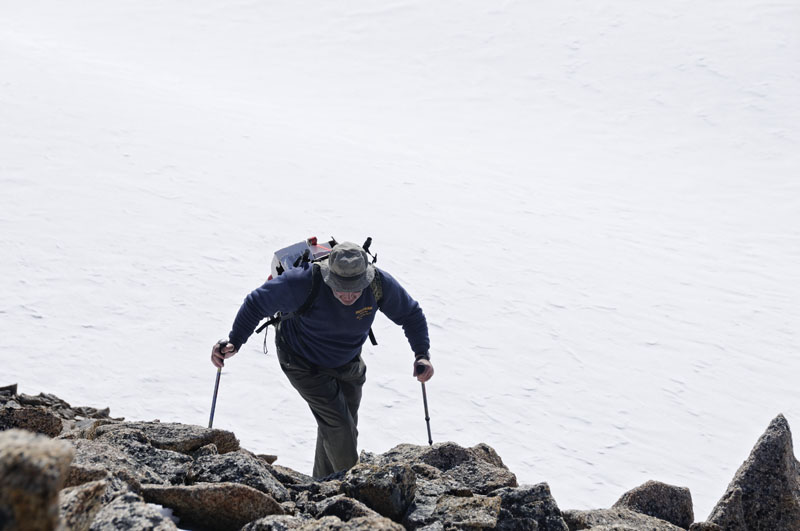
Keith, carrying the battery. |
|
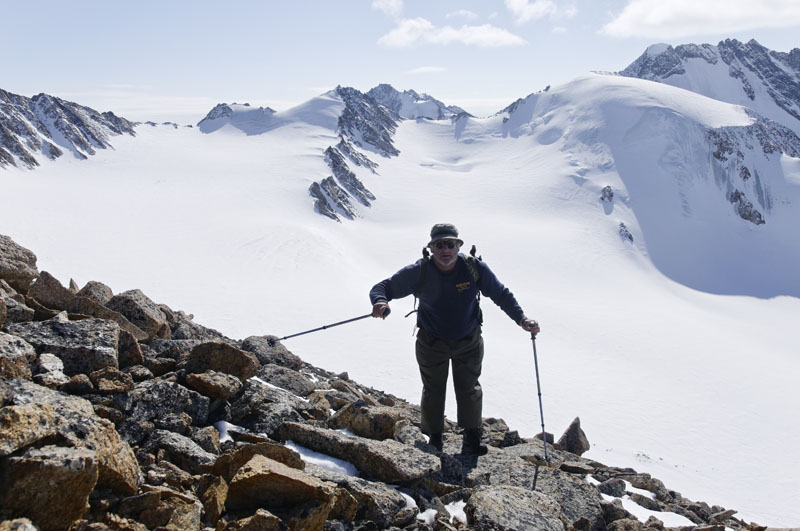
|
|
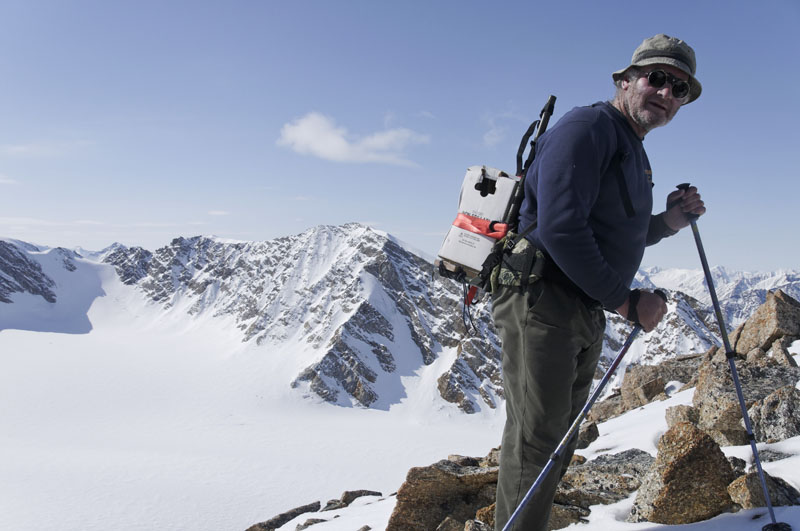
|
|
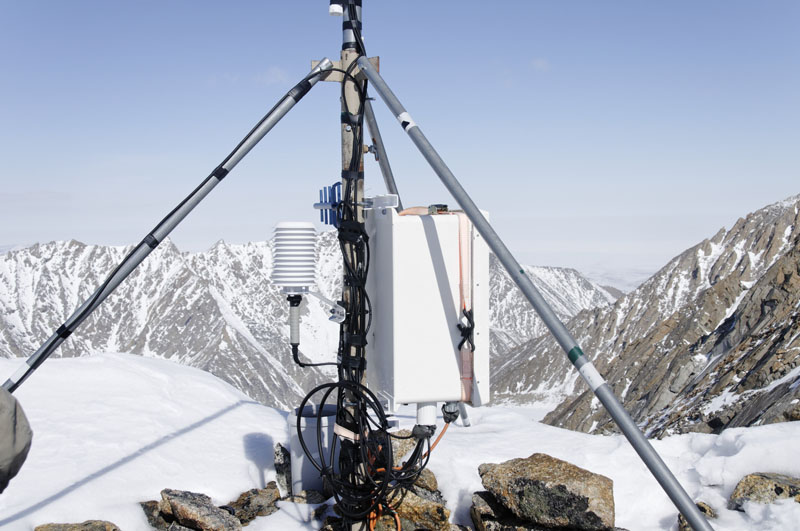
|
|
|
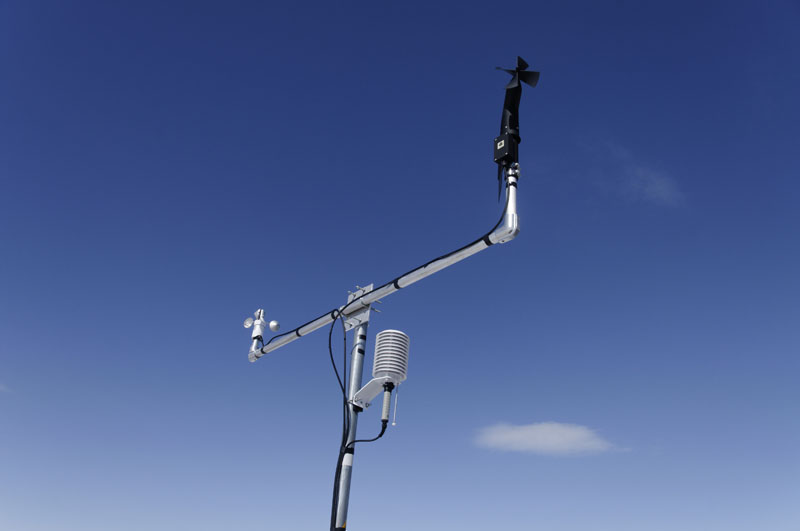

Me, installing the battery.

As far as I know, this is the highest weather station in Alaska,
and certainly the Arctic, and even if it isn't, I'm sure it's
longest continuously-operated weather station at this elevation.
Not that I'm bragging...
|
|
|
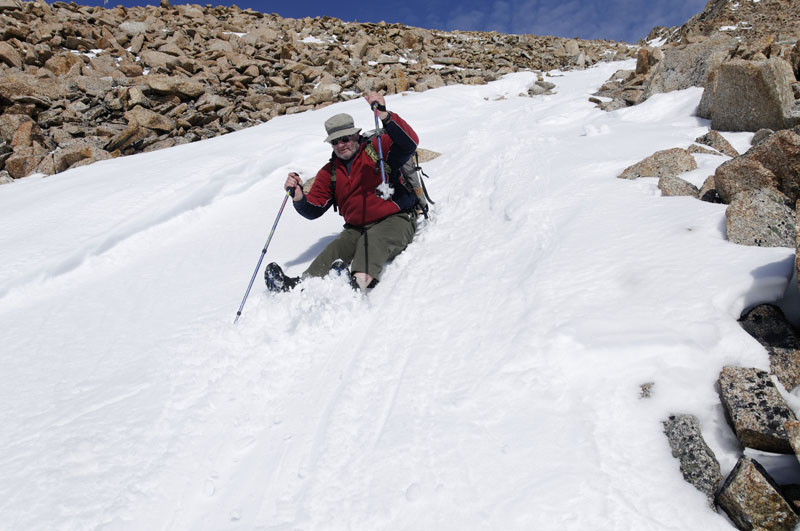
Keith's always looking for ways to save on toilet paper...

Full Moon over McCall Glacier. Keith is a man of few words but
clear in his meanings.
16 May 2011 McCall
The next day we decided to
head down to the terminus, something I later regretted. The weather
was fine, though occasionally foggy and breezy, and after some
scrambling to get gear ready we headed downglacier. I was the
tour leader, stopping along the way to point out things that might
be of interest to glaciologists. It was after 1PM by the time
we got off the snow machines to walk down the steeper part of
the ice. Kristin and Turner were planning to ski down, with the
idea that I would pick them up on the way back. I kept them updated
to not leave too early, but was hearing the clock tick in my head
too, as I had wanted to do the mass balance survey today and had
hoped to be starting that by now. So I was getting increasingly
stressed, and realizing that I had forgotten some gear and was
not really ready to do what I needed here didnt help. We descended
to the valley floor through the fog, me first in a hurry. Andy
and Mike hauled a sled full of their pollen trap station, while
Keith ambled between us.
I had two weather stations
here to download, install a pressure transducer in the stream,
and set up a time-lapse camera. The downloading was really frustrating,
as it kept cutting off after only a few percent of the total transferred.
Then it took 30 seconds to reconnect, then try again. It was a
process that should have taken 5 minutes that took over an hour.
The other datalogger was equally ornery, but only took 15 minutes
instead of 2. In the meantime, Keith was helping install the pressure
transducer in the stream. Unfortunately the stream was choked
with 1.5 meters of snow, unlike last year when it only had 20
cm of ice. I had brought a shovel with us, but left it with the
snow machine, so Keith was resorting to hacking a hole with a
ice axe and a piece of conduit. I had planned to raid a mounting
structure for the time-lapse camera from an upper site, and even
though we stopped there and I fiddled with it, I got distracted
and forgot to bring it along, so had to rig something hokey. So
after an hour or more of such screwups, I was pretty frustrated.
Added to this, Andy decided to install his trap not where all
of my equipment was located, but somewhere closer to the terminus
which I still couldnt see due to the fog, and I was cursing myself
for not sticking with my plan of knocking out the mass balance
this day and leaving this lower priority stuff until later, and
further cursing myself for getting frustrated in the first place.
We all finished up about the same time, and Kristin radio'd about
that time something incomprehensible due to the distance, so I
just packed up and hiked as fast as I could back to the machine
to figure out what their situation was and hoping to head back
and have a few stiff drinks. It was almost 4PM by the time I got
there. I hadn't looked back on the way up, and it didnt matter
much anyway since it was so foggy, but by the time I was ready
to go the others had caught up so we headed back together. It
was the first day of the trip where I had let myself get thoroughly
grumpy, but I guess on the bright side this was day fifteen of
the trip rather than day one as in many other trips. But Keith
was always good for a laugh, whether intended or not. As we about
to get started, Mike asked whether he should put on the brake
for the sled, and I hesitantly said 'well, we probably dont need
it going uphill', to which Keith translated 'fuckhead!', and I
added that 'you could if you wanted', to which Keith added 'yeah,
why dont you just wrap the fucking thing around your neck and
we'll drag you!'. Such was the normal state of conversation.
I headed up to camp when we
returned to get the GPS ready so that the next day I could do
both the mass balance and GPS together, while Andy and Mike headed
to the upper cirque to continue working on their main pollen station.
I plugged everything in, made some test measurements, and everything
seemed to work well, so I was encouraged by that. About the time
I had finished with that, it began to snow, and not long after
that it began to get windy. It seems that east winds are the main
ones that bring both wind and snow, and within a few hours there
was significant accumulation and drifting. We enjoyed a nice tuna
steak dinner during the storm, and talked a bit again about science,
politics, and public insistence on believing in stupidity rather
than reason. Mike was particularly interested in figuring out
how he could best help society. Nobody seemed to buy into my suggestion
that the best thing he could do for society was to kill himself,
else he would per force be part of the problem. Reiterating that
occasionally through the remainder of the conversation didnt seem
to sway any opinions.

Off to storm the castle...

Ditching the snow machine to head to the terminus.
|
|
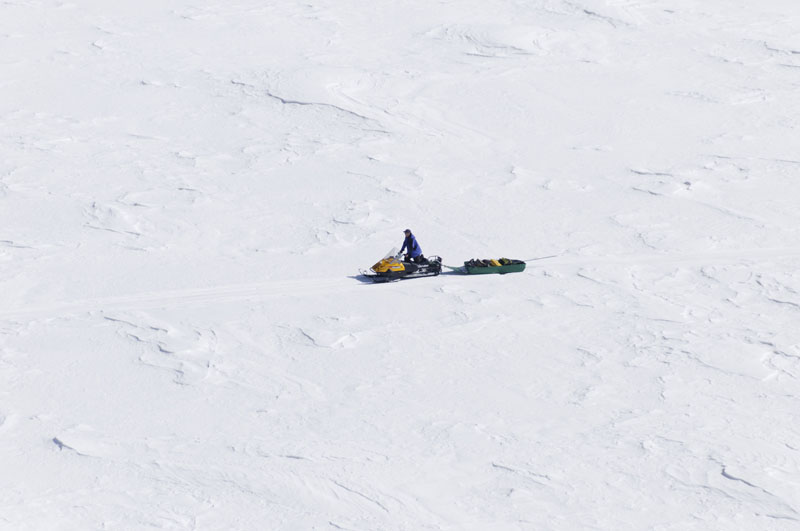
Having two snow machines was very nice for me. |
|
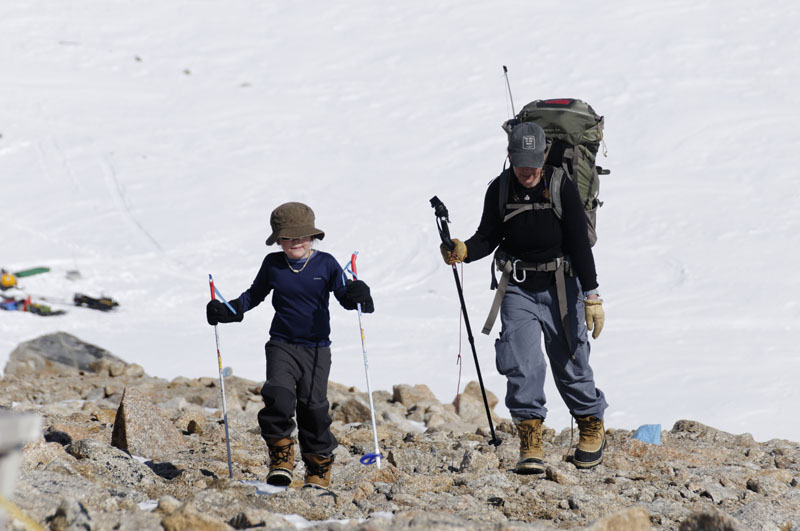
|
|
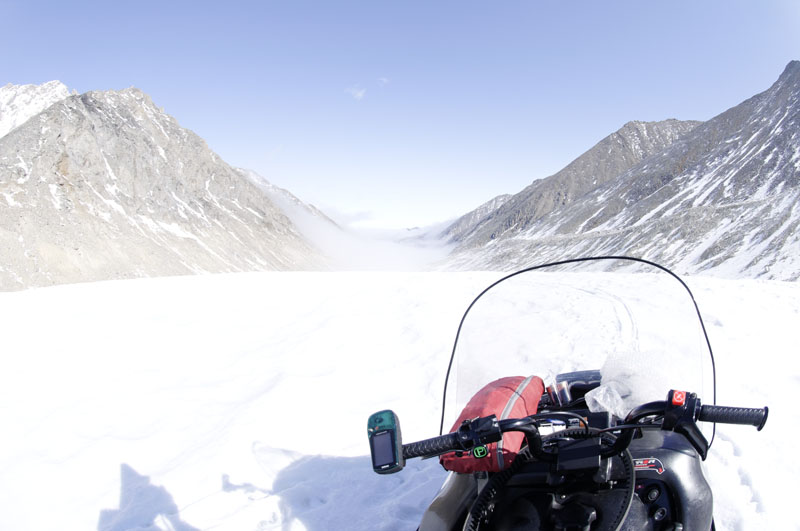
The terminus was choked with fog. |
|
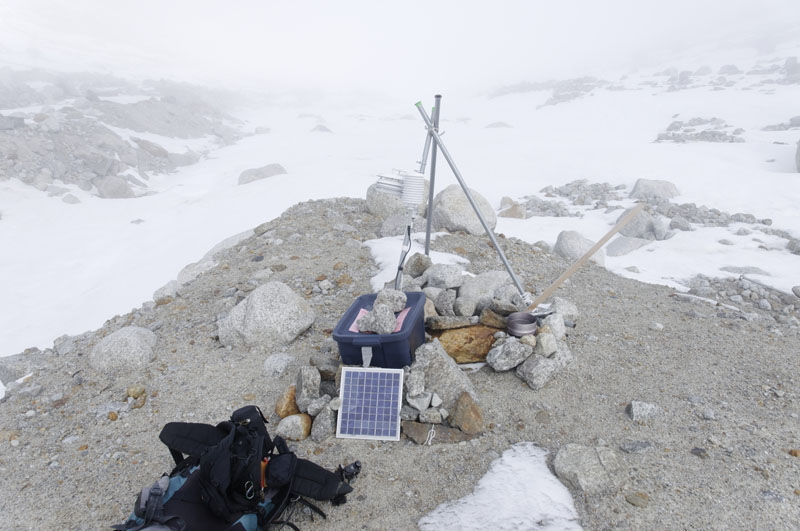
See? |
|
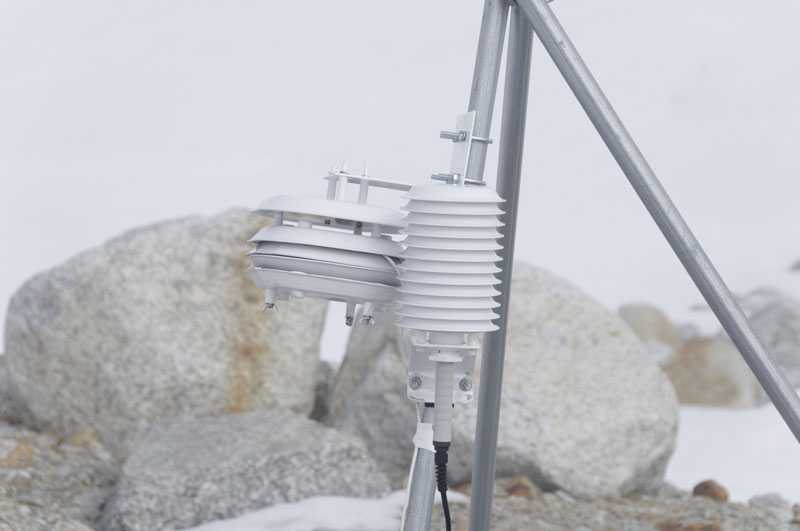
|
|
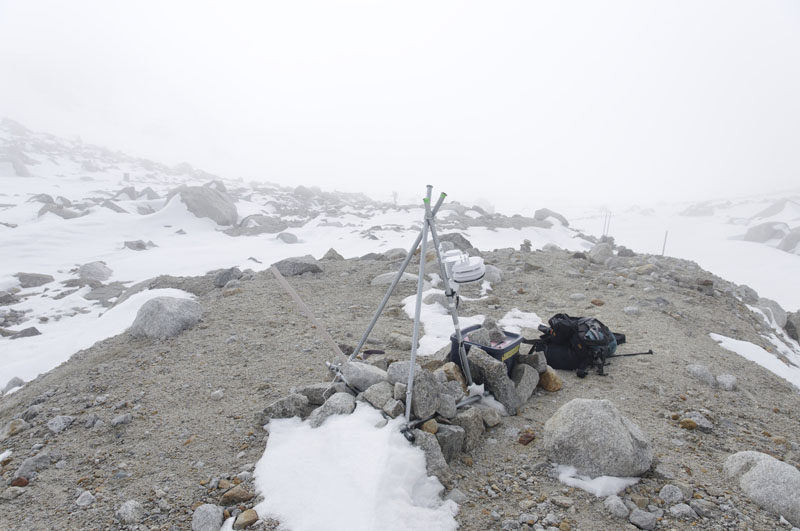
|
|
|
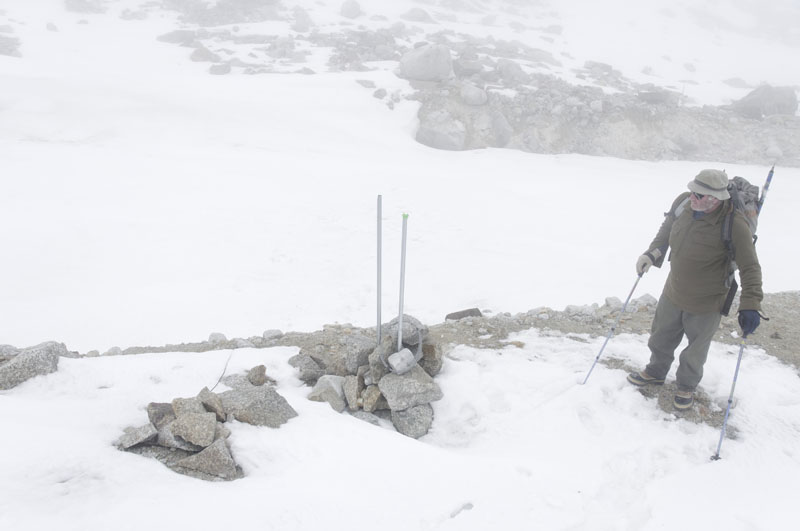
It's tough siting in a time-lapse camera when you cant see the
target.

Finally a little GPS action.
|
|
|
The storm raged through the
night, rattling the tents, and making drifts through camp, but
by morning had largely subsided. We all slept in a bit, but by
10AM I was itching to get going on the baseline measurements.
It was still windy, but the sky was largely clear. By the time
I actually started, fog and snow had rolled in, and by the time
I got to the second set of poles just down from camp, visibility
was zero and the old snow machine tracks were completely obscured.
Heading to the terminus in such conditions is a recipe for disaster,
as the substantial bare ice there is hidden by this dusting of
snow and flat light, such that the snow machine tends to spin
in circles unexpectedly, and getting off to walk has similar frictionless
results. So I headed back to camp, resuming my frustrations from
yesterday and wishing I had already finished all this rather than
have gone to the terminus. Part of it is probably an ingrained
need to be frustrated occasionally, but part is also being so
close to the end of the trip. Usually I only get an afternoon
to myself to take some photos or hang out, and it seemed this
trip would be no different despite it being over 3 weeks long;
plus I had already had my afternoon on the way down from Ahab
and so had nothing further to look forward to. So here it was
Monday, knowing that by Friday we would be packing up, and still
having all of the mass balance and surveying to do and not yet
having even opened up the ice radar. In any case, I headed up
the hill to find Turner and Kristin about to start watching a
movie in our tent as part of some compromise deal they had worked
out, so I joined them rather than sit in the fog and be grumpy.
By the time the movie was over, the skies had cleared so I headed
back to the glacier. By the time I reached it though, we were
once again in fog, so I headed back to camp, where I tried downloading
the weather stations outside our tents only to find them fried.
But after a while dealing with this, another break in the weather
opened up, so I headed back down.
I went straight for the terminus
first before the fog returned, not wanting to get stuck on the
slippery surface with no visibility. My old tracks were gone,
and on the last and trickiest hill I had some interesting mobility
issues, again wishing I had finished this the day before rather
than getting trapped under a snow machine on my own, but in any
case made it down without incident. As I was standing on the handle
bars of the machine to get the GPS antenna on the lowermost pole,
I noticed the fog quickly coming up the valley, and did my best
to get moving upglacier as I didnt not want to try to drive up
the trail I just came down but rather pick a better route. Unfortunately
the fog won, so I was committed to following my track back up
with predictable results. The ice beneath the thin snow was incredibly
slick, and once sliding backwards on it there is little to do
beside try to keep the machine upright and hope to find a thicker
snow patch that the track will catch on. But eventually I did
crest the hill onto firm snow and was able to survey all of the
poles on the glacier below camp. The entire process took less
than 3 hours and I was back in camp by about 7PM. The others had
already been back a while from their work finishing up in the
upper cirque, so just before dinner I downloaded all of the GPS
data I had just collected to ensure that everything worked out.
Predictably it didnt, and I got caught by the bug that shuts off
the GPS base station at midnight UTC time, which is 4PM our time,
which is 10 minutes before I left for the survey. So all of the
GPS data I had collected this evening is essentially useless.
It didnt really phase me much though, as I felt it was just rewards
for not keeping my sense of humor in tact. We still have plenty
of time to do everything I had intended too, provided I stop acting
like a fuck-knuckle and do what I do best. Whatever that is.
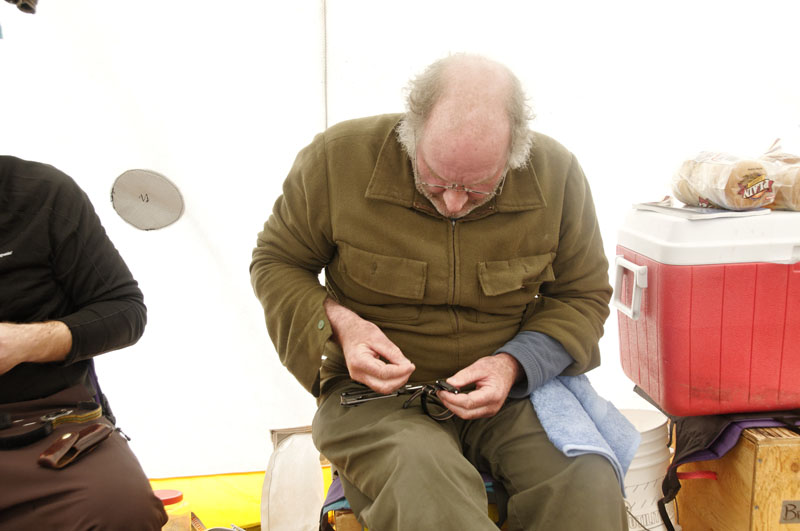
Storm days are a good time for gear repairs.
|
|
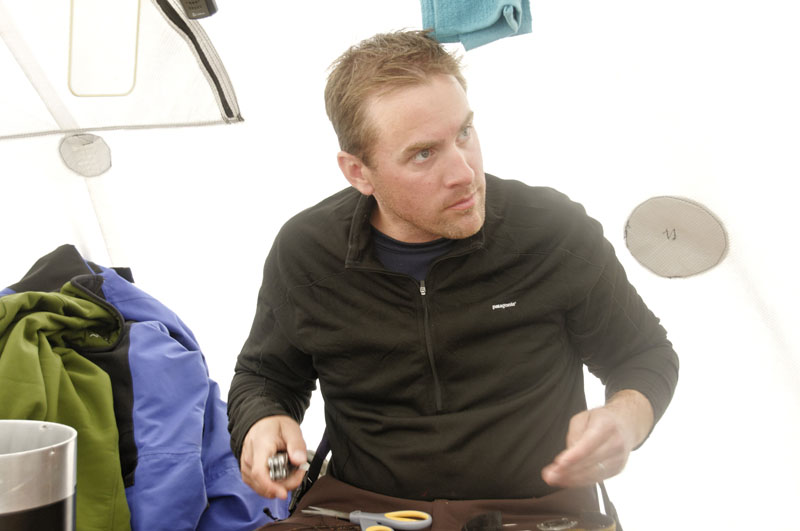
|
|
|
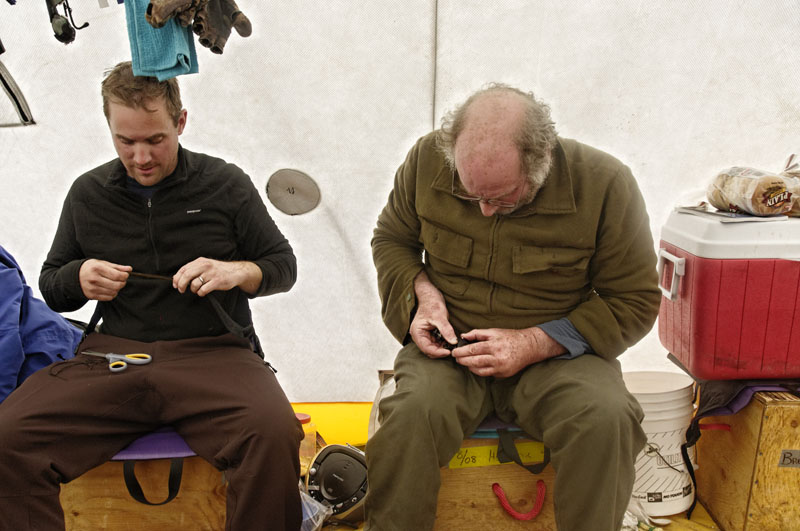

It's hard to stay grumpy around this family.
|
|
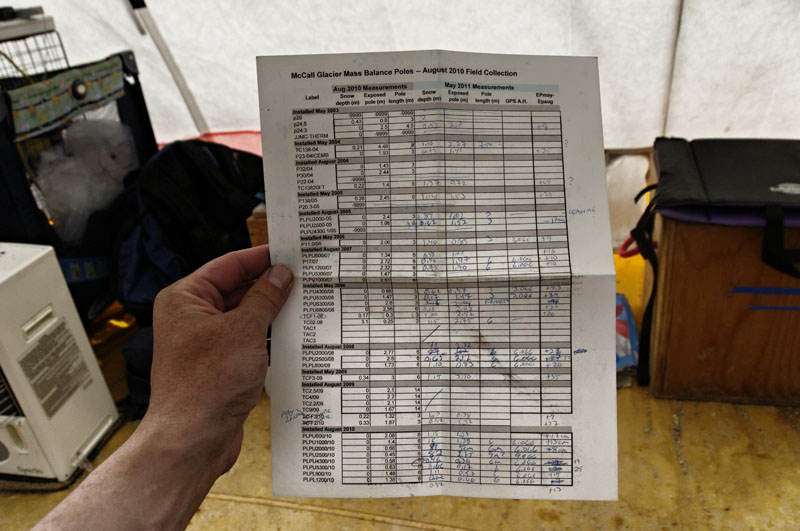
My mass balance cheat sheet. |
|
|
19 May 2011 McCall Glacier
The next day I was able to
complete the mass balance and velocity survey. I woke up about
6AM, got my gear organized, and was walking down the hill just
after 7, my earliest start yet. I figured it would take less than
2 hours to repeat the GPS survey, so I would be back by the time
the others were waking up and having breakfast. Unfortunately
the snow machine was nearly out of gas, so I headed up to the
upper cirque to fill up. We still had no pump with a filter, so
I pumped into a 5 gallon can, then added Heat to it as I filled
up. By the time I got to the bottom of the hill it was clear that
something was wrong, likely some ice in the lines. I had planned
to go to the terminus first, but figured that I should work more
locally until the fuel issue had sorted itself out, as the last
thing I needed was to not have power trying to climb the last
slippery hill that had given me problems the day before. I cruised
through the lower cirque and confluence, but I could never get
the engine to really open up. I decided therefore to switch machines,
which meant setting up the GPS on the back of it and moving gear
over. In any case, these delays in total cost me an hour, but
I was back at camp at about 10AM to confirm that I could successfully
process the data, which indeed I could.
The next step for me was the
upper cirque. There are nearly as many poles here as on the rest
of the glacier, plus more snow pits to dig. The rest of the crew
came up as well, as Andy and Mike wanted to fiddle with their
station a bit and Keith wanted to dig out the freezer and get
it up onto the surface. By the time I had finished all of the
pole measurements, they had given up on the freezer, which seemed
to be securely stuck into an ice layer at the bottom. Andy and
Mike decided to climb to the col to see the view of Hubley. By
now clouds had moved in and were moving quite fast just above
us. I dug snow pits at our drilling sites, while Keith sorted
the drilling gear for storage. By the time we were all done, Andy
and Mike had tried unsuccessfully to sled down the hill, and we
ended up back at camp around 5PM to enjoy a mexican night with
margeritas, as this was to be Andy and Mike's last day in camp.
The plan was for them to head out in the morning to do some lake
coring and base out of Deadhorse until they were finished. So
in all it was a productive day, and all that remains for me is
some cleanup work and the ice radar project.
The next morning I woke up
early to check weather and hopefully finish up some of the clean
up items. A light wind had developed, which at first I thought
was just a local reorganization, but seemed to be getting stronger.
I called Mike at 70N about 8AM and told him I would call him from
the skiway in an hour to see how conditions there were. Unfortunately
the winds continued to strengthen, blowing about 10mph at an angle
down the runway, so we decided to hold off flying for a few hours
to see what the weather would do. I headed up to the upper cirque
to see if I could fix my main station there, which had been giving
me fits for years and was now completely dead. This time it was
the battery, as even after jumpering in a new one I could not
communicate with the logger. The wind was blowing snow here, changing
to nearly every direction, so first I had to rig up a tent around
the logger box which I could crawl into and work on the electronics
without it getting covered in snow. I pulled out the old logger
and installed a new wiring, rewiring all of the sensors. In all
of the years I've run weather stations, this is the first time
a CR10X has failed on me. In any case, it seemed as though everything
was functional now, so I headed back to camp, where the others
had begun schlepping gear up and down the hill as needed, something
that would save Keith, Kristin and I a lot of time and stress
at the end of the trip, and keep me focussed on science. The winds
were still strong, and seemed to be getting stronger. Fortunately
they were from the south and quite warm, so it wasnt unpleasant
to be in them particularly. We enjoyed a nice lunch of quesadillas,
after I called Mike to tell him that the winds here were still
too strong for flying. Afterwards I went down the hill to bring
my ice radar up from the cache to start prepping it, and when
I returned everyone had gone to their tents to nap or read.
I worked outside, using a pile
of boxes as a bit of a shield against the wind. As I was sorting
through the gear and trying to remember how it worked, I heard
the familiar sound of an outhouse tent soaring over my head. I
dont think it even touched the ground as it went zinging over
the GPS and out of sight down the steep hill to the glacier. Kristin
and I peered over the edge but couldnt see any sight of it. A
similar thing happened to me in a storm in 2008. After finishing
up a bit more preparations, I headed down the hill with the radar
to give it a shakedown and search for the tent. I dropped off
the gear and headed around the corner downglacier to look for
it, and found it at the base of the hill, in what would be a small
river in summer at the connection between the glacier and mountain.
I drove as close as I dared, knowing there were small crevasses
along the glacier margin here, and predictably stepped from the
snow machine directly into one, but fortunately it was not much
wider than my foot. I probed my way over the tent, managed to
fold it up in the wind, and got it back to the base of the hill
below camp, where I then started in with the ice radar. I got
some of the physical rigging sorted out, but when I went to try
to use it I discovered the small laptop I had planned to use with
it was out of battery, so I head to head up the hill to find a
spare, then back down to try to use it. Mike was helping out by
this time, and we made some tests first dragging it by hand, and
then by snow machine. Given the somehow hokey setup and lines,
it wasnt exactly clear whether I was seeing the bottom or not,
but at least everything was more or less functional, and this
was about as far as I had hoped to get today. By now it was after
6PM, and the winds showed no clear signs of letting up, so we
decided to bag any flights for the day. It was getting downright
hot, and the snow was the mushiest we had seen it yet, with tons
of loss from the rocks and lots of ice exposed in the steeper
areas. This wasnt so much by melt, as there was little meltwater,
but rather by sublimation, as the warm air simply carries away
the surface moistures. That night we enjoyed spaghetti and meatballs
with a movie, as the tents shook around us, hoping for better
weather in the morning.
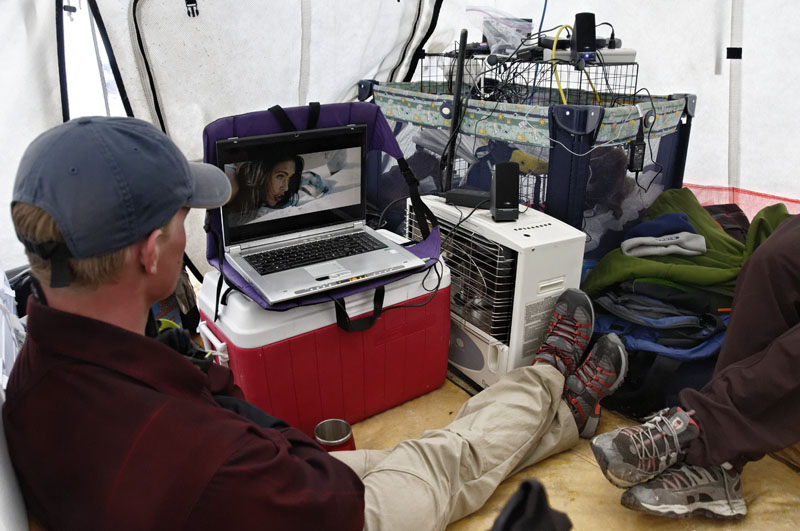
Movie night -- Transformers 2
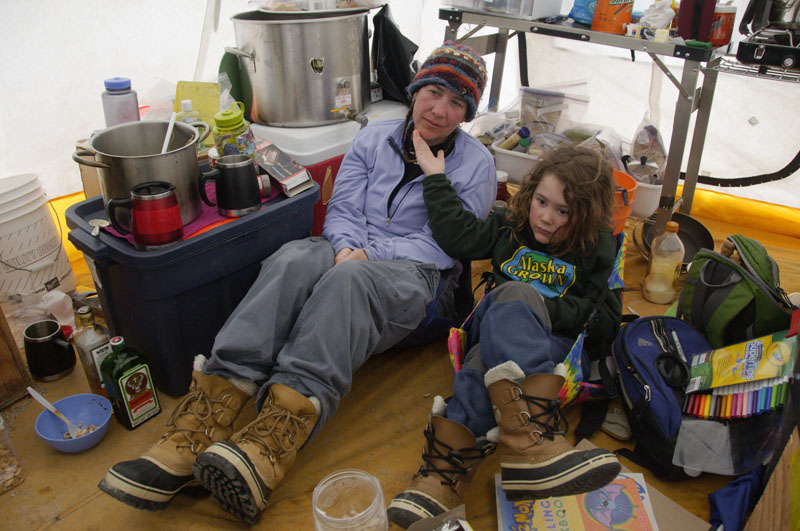
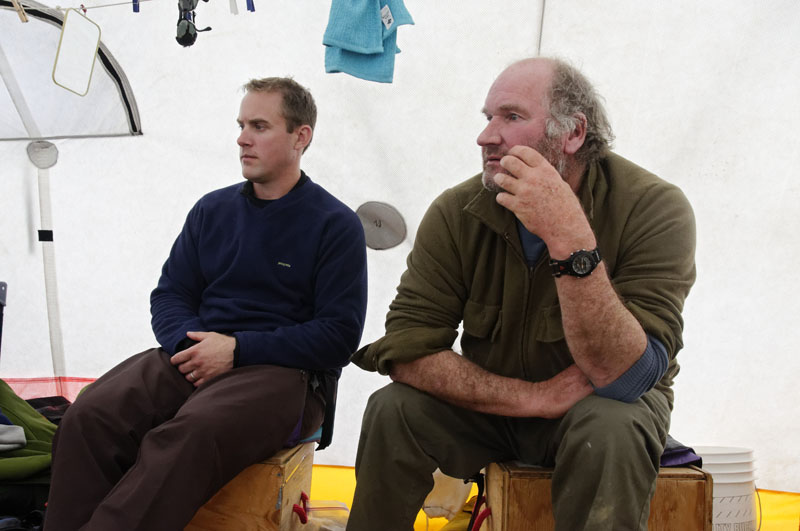
21 May 2011 McCall Glacier
The next morning the weather
was better, though warm and a bit windy. The winds were coming
from the south, bringing the warm air to us. I worked on the radar
down by the skiway, both because it is was a nice long flat area
and also so that I could keep an eye on the winds. The radar was
problematic. I couldnt get it to trigger properly, and it seemed
to me that there might be multiple problems. Having no direct
experience with radar, it was difficult to troubleshoot and it
occurred to me that some of the components may not even be functional,
since they were brand new and never tested. About noon I gave
Mike a call to let him know that conditions were the best we'd
seen -- no down glacier wind and good visibility, so we decided
to check back in an hour to make sure the trend was staying that
way. I headed back up to camp to have some lunch and make sure
the travellers were ready, then head back down to groom the runway
a bit and fool with the radar. About 3PM I brought everyone down
to the runway and we waited for a while until we heard Bob flying
overhead about 3:30PM. He tried landing long on the skiway so
that he would get maximum takeoff run and then tried taxi'ing
further but only got a few feet. His skiis are wheel penetration
skis, which means there is a hole in the skis that the wheels
partially penetrate through such that you can land on pavement
too. The problem is that these create a lot of drag on snow, especially
mushy snow like we had now. In any case, we unloaded his cargo,
a bit of lumber to make a snowmachine platform and a fuel pump,
and then turned him around. We ran downglacier on the snowmachine
to give him a view of what conditions were like, then loaded up
Andy and Mike and their gear.
In his past take-offs, Bob
was off the snow in 200-300 feet, but it was clear here that the
mushy snow was not going to permit that, and was balling up on
top of his skiis, weighting him down. By the end of the marked
runway, he was still barely moving and decided to call it quits.
By this point, he was at the top of our usually skiway, which
we had abandoned this year due to large drifts. In this case,
though, the drifts seemed like an advantage as the snow was much
harder there. So we kicked out the passengers and gear, got him
lined up with the old skiway, and watched him slowly gain speed
and get airborne. We were glad of this after this several hour
ordeal, as it would have complicated all of our lives to babysit
the plane on the glacier until conditions improved.
At this point we changed plans
for our take out. The general idea was that Andy and Mike would
fly out first on Sunday with Dirk to Okpilak Lake where they would
meet Bob and take a sediment core. Then Dirk would fly the rest
of us out to the lake and shuttle any remaining gear, and hopefully
everything will fit into the two planes, which would fly back
to Coldfoot. It's all weather and conditions dependent of course,
but the good part about it all is that we would have more manpower
to pack up camp and finish all of the little remaining tasks,
and that I could have another day to concentrate on the ice radar.
The radar project is attempting
to finish up what we started last August and to gear me up for
future work. Our main goals on McCall Glacier is to map out the
transition between warm and cold ice, which we demonstrated last
August that it does pretty well. I bought my own system this spring,
which only arrived a few days before we left for this trip, so
I didnt have much time to do anything besides plug everything
in and make sure I had all of the pieces. The radar transmitter
is tiny, and it sends out pulses through a long wire. Another
set of wires is attached to the receiver, which consists of a
oscilliscope hooked into a computer. The computer controls the
acquisition rate and stores the data from the oscilliscope, which
is plugged in through a usb port. GPS data is also acquired and
stored simultaneously through a usb port. My goal was to make
it single-person operation towed by a snow machine, so that we
could get better spatially coverage efficiently. I had a lot of
problems getting a good signal, which was complicated by my lack
of experience with it and not really being sure whether the components
were functional since they were all brand new and not tested.
My primary goal this season was simply a shake-down to get it
operational, so that next August we could fly to other glaciers
in the area and get a survey of ice thickness and ice temperature.
So far I was having no luck.
The complications with Bob's
landings chewed up the rest of the day, so I woke up early the
next morning to get a head start on the day, as it was the last
I would have available for science. I plugged everything in at
the bottom of the hill, using the same settings and setup as the
previous day, and it seemed to work properly right off the bat.
So I loaded it all up and headed down to the skiway to check conditions
there and try some profiles. It was still warm, with south winds,
with air temperatures over 5C. The snow on the skiway was hard,
but still mushy elsewhere. I talked to Mike at 70N about our new
take-out plan, and he agreed it was a good one we should plan
on. So I continued on with the radar and actually got a good bottom
profile, and after some fiddling with settings learned that I
was also seeing the warm-cold transition. Unfortunately at this
point I had some trouble with the antennae themselves, as apparently
they were not secured properly in their housings. It took about
two hours to sort this out and hack something together that might
work, but afterwards I was able to spend a few hours collecting
profiles in the lower cirque where we knew there was a lot of
interesting things going on with ice temperatures. In those few
hours, I probably collected more profiles than we had last August,
with two teams of two people for 10 days, so I was glad that the
shake-down was successful and that it seemed we got some good,
useable results.
In the meantime, the others
had begun working on the old snowmachine. It was still suffering
from a lack of power, after I filled it a few mornings earlier
when doing the GPS velocity survey. By the time I got there, they
had changed the fuel pump back to the original one, but this did
not solve the problem. We had a new pump with a water blocker
and filter, and had pumped the gas out of the tank into a jug
and pumped it back into the machine, and this also did not solve
the problem. The mechanics seemed functional, as one could drive
it normally by using the primer to pump fuel directly into the
carburator, but as soon as this ran out the fuel pump would not
keep it going beyond idle. When you worked the throttle, the engine
just when blah and would not fire. Priming more fuel into it would
bring it back to life. So it seemed that the fuel was fine, there
was just something wrong with the main fuel supply. We pulled
off the fuel tank, examined the fuel filter, and reassembled everything,
and still did not solve the problem. Our next thought was perhaps
it was something to do with the oil mixing system, as the oil
level seemed to drop more rapidly than it should have. So we disconnected
that and poured premix into the tank, with no luck. So at that
point we were out of ideas. I had hoped to continue the radar
survey into the upper cirque, but unfortunately when I tried to
turn the system back on, the radar transmitter would not turn
on and after some troubleshooting I gave up on this too, as it
was after 7PM. So it was a disappointing day in some respects,
but very successful in others.

Unloading supplies.

Are we having fun yet?

"Well, they think they are going somewhere..."
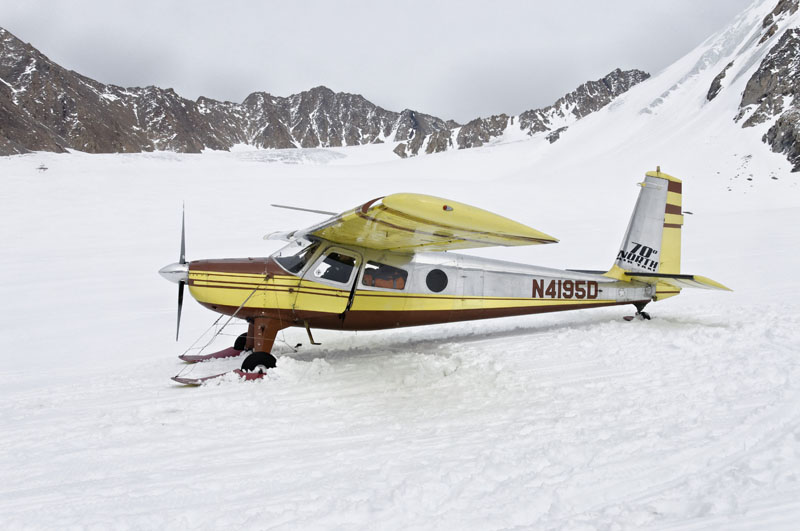
Loaded up and pointed the right direction.

Suckers...

"Told you so."
|
|
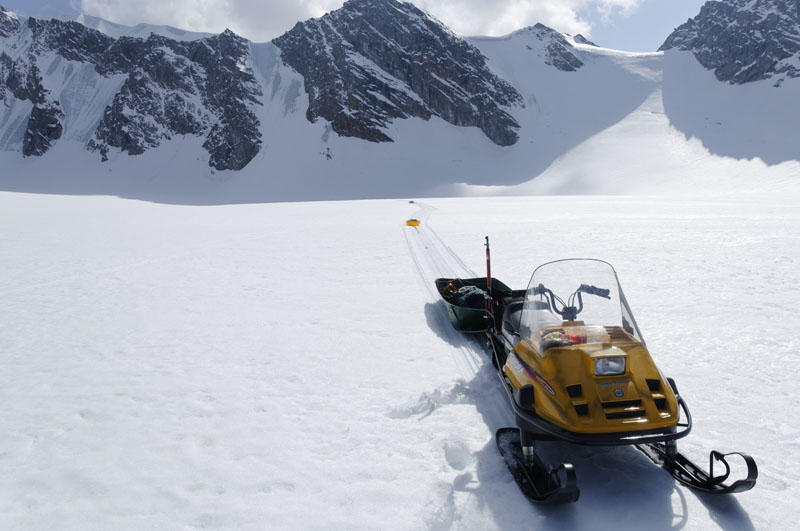
The radar setup. |
|
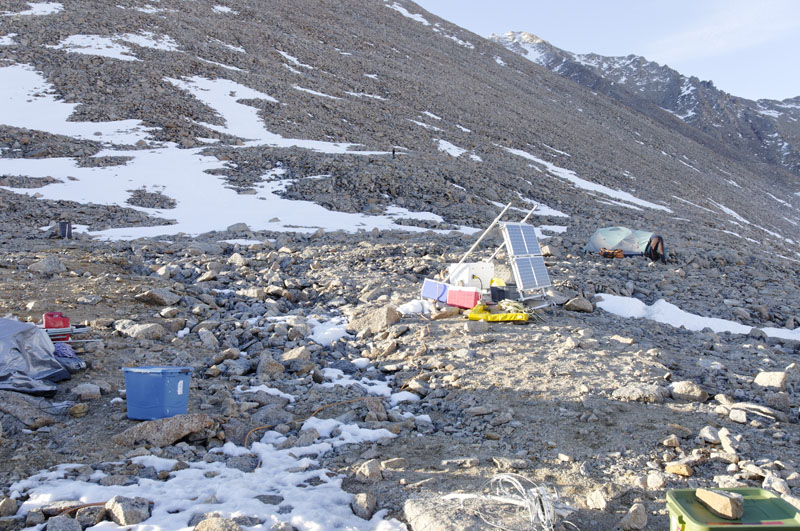
Turner liked exploring around camp on his own. |
|
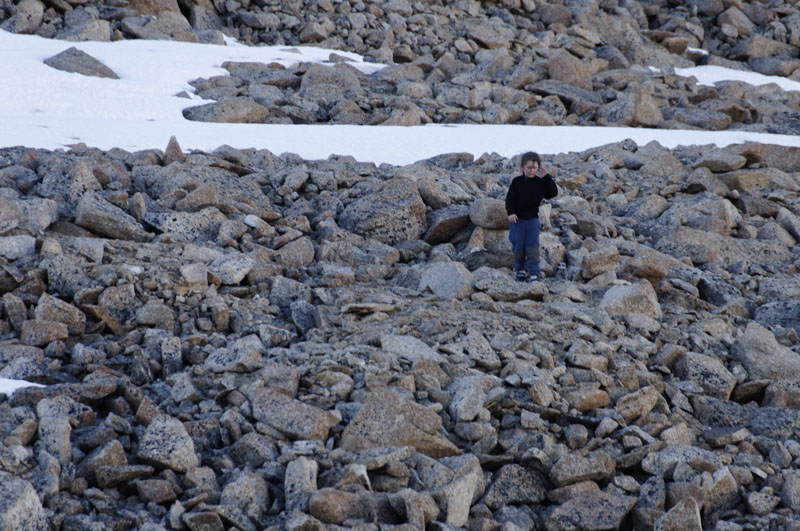
|
|
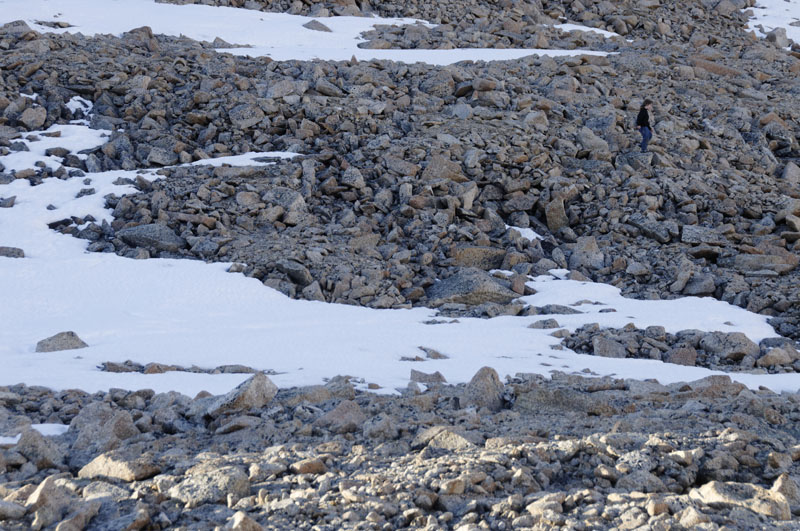
|
|
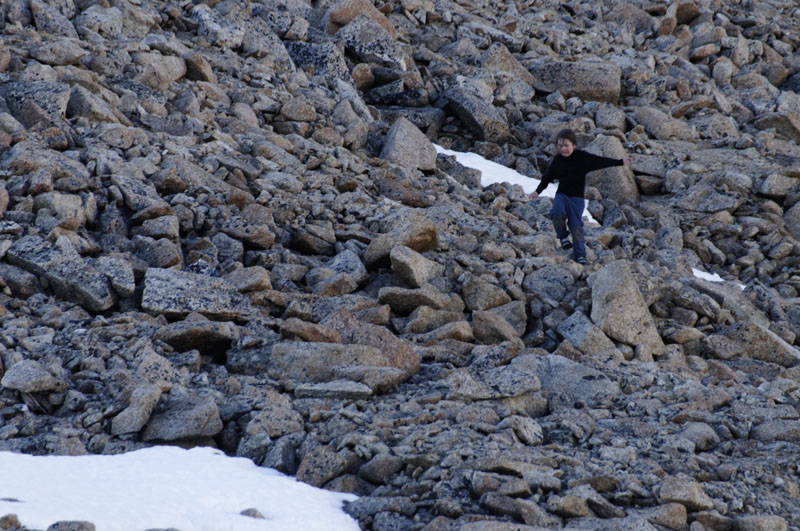
|
|
|
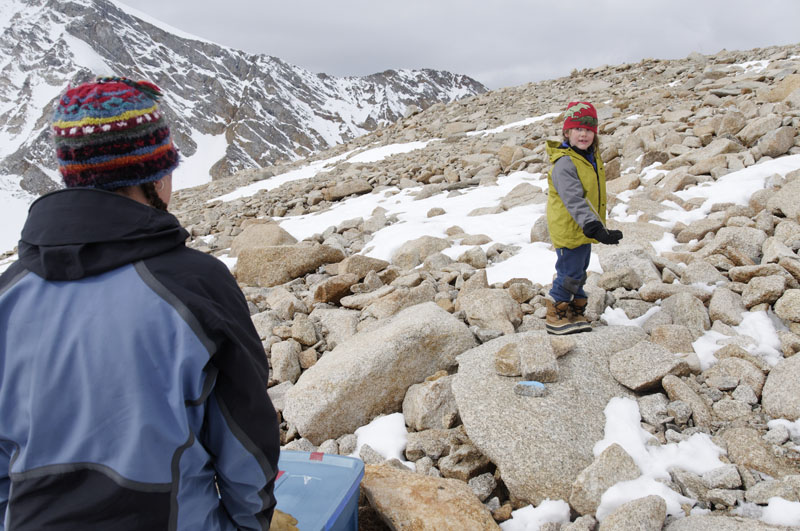
He also liked exploring for dinosaur bones.
|
|
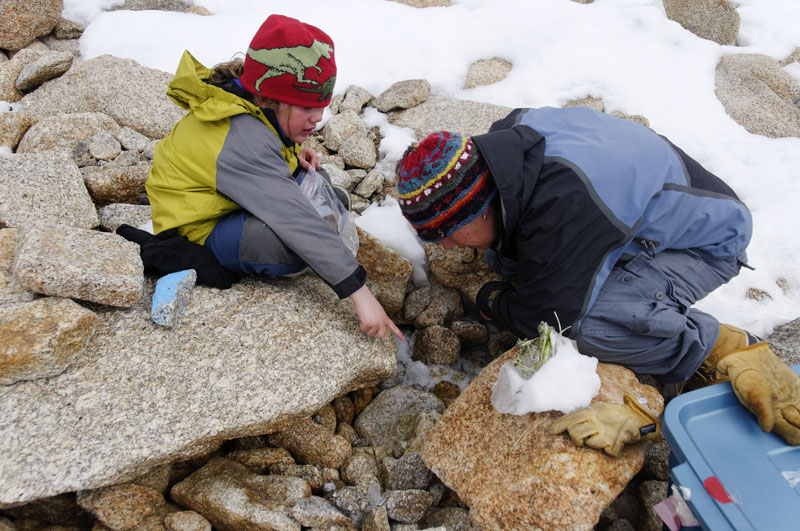
In this case, the evolutionary descendent known as ptmarmigan. |
|
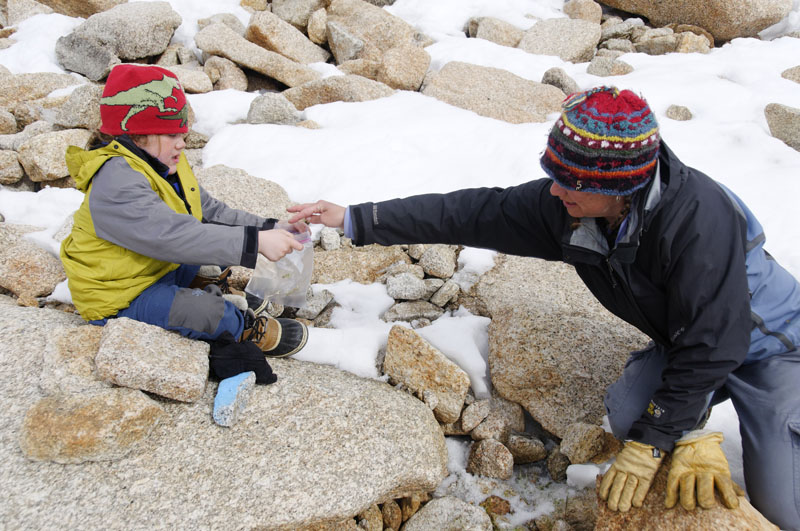
As long as he didnt have to touch the yucky parts. |
|
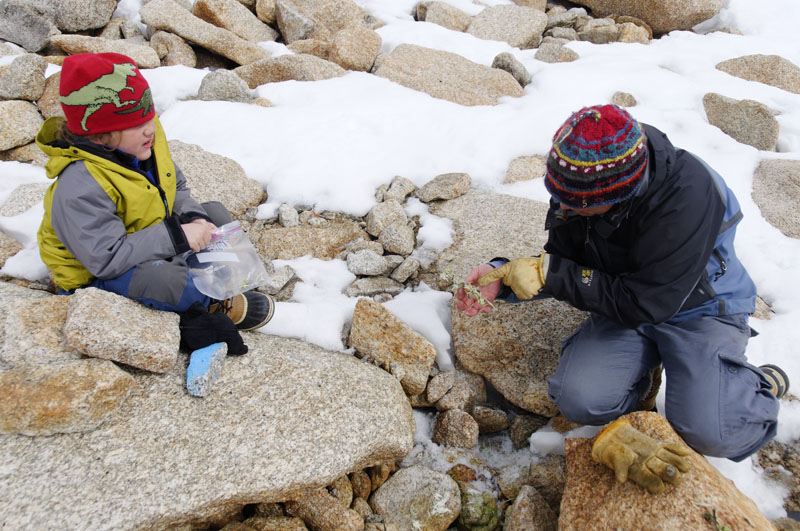
"I was kind of thinking of older fossils..." |
|
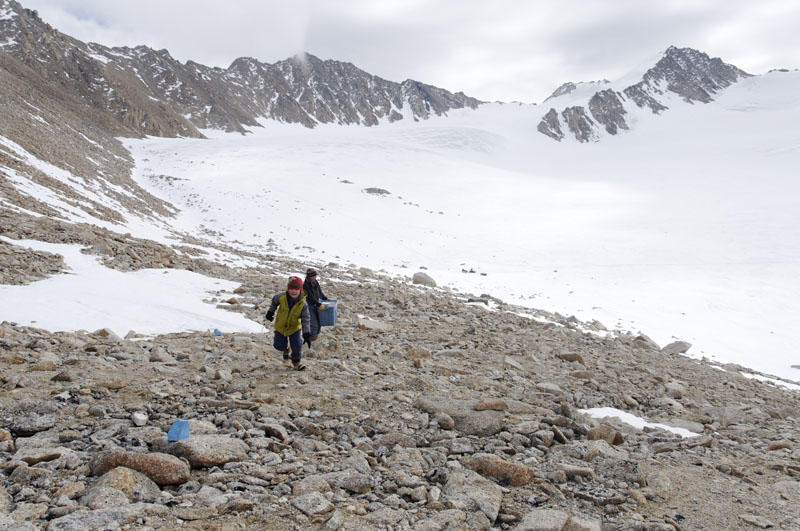
Back from a successful dig. |
|
|
The next morning, today, we
are packing up camp and getting ready to leave tomorrow. Most
of the cleanup necessary is my science gear. In some respects
I feel like the trip never really started, as the starting seemed
to happen in waves. I never had the chance to organize my gear
and get into an efficient mode, having focused initially on only
the ice coring and as soon as that ended the others showed up
and it became a blur of activity organized as needed. As I began
to feel more and more behind, I began working earlier and ending
later, and in the past three weeks I've only had at best a few
hours to myself on the way down from Ahab where I took a panorama
and sat on a rock for lunch to take in the view. It was nice having
such civilized working hours during the beginning, but I think
to keep that up we needed a few more days to really do the best
job and have some free time, or just leave the take-out date open
ended so that we can proceed without the stress of a hard deadline
and finish all jobs to full completion. All of our science goals
have been met, but the things that get cut are the QC that gives
me a warm fuzzy feeling that it was all done fully and correctly.
The ice coring part of the trip seems like a lifetime ago now,
but looking back on it all we really got a lot done, having fixed
a number of weather stations, maintained a bunch more, got the
mass balance and velocity survey done, and collected a lot of
radar data. In addition to this, Andy installed 5 or more new
pollen traps and revamped his main station to survive a few more
years. So there's nothing to complain about, it just feels a little
rushed at the end and with a few more days I might have left with
all of the data reduced fully and double checked for accuracy,
as well as gone for a picnic or hike.
The latest finding as of about
noon is that the trouble with the black snowmachine now seems
clearly related back to fuel. Last night we had filled up the
yellow machine from the same barrel. I ran it a bit then and it
seemed fine, but today it is experiencing the same symptoms as
the black one. This complication could blow our take out plans,
as manhauling the remaining gear is problematic in the soft snow.
Fortunately with the extra manpower, we have some options. The
others are hiking to the upper cirque right now to get the barrel
we have some confidence has good gas, as both machines seemed
to operate fine with it during the trip. Hopefully there is enough
there to get both machines functional again to point of assisting
with the takeout, and in the future I think we'll just have to
plan to bring in fuel for each trip. We only used about 15 gallons
this trip, so this shouldnt be too big of a chore. We had only
been storing it here because a year or two ago, a miscommunication
ended up with a number of empty barrels being sent out and coming
back full. It seems like the problem with it is more than just
some water getting in, as the water blocker on the fuel pump should
have solved that, but not sure what else it could be other than
loss of volatiles. I had thought my biggest screw up of the trip
was not bringing in Heat and misplacing the fuel pump, but it
seems at this point that this would not have avoided the problem;
rather my biggest screw up occurred last year by not stabilizing
the gas or bringing in fresh. But it's still not clear what the
problem actually is, as every time we think we've got it figured
out, something else comes up. So we'll see what the rest of the
day brings. |
|
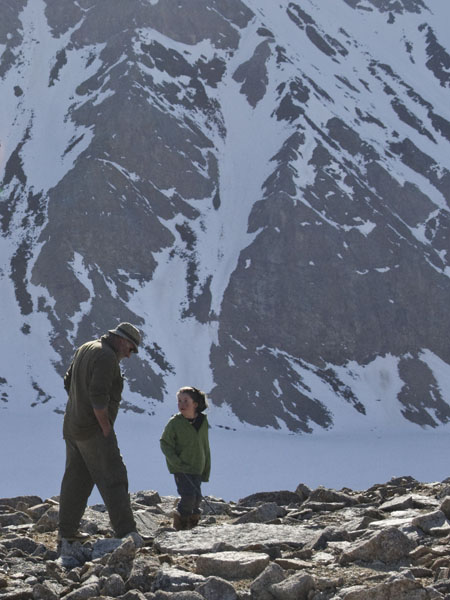
"You can be Yoshi or Luigi, but I'm Mario" |
|
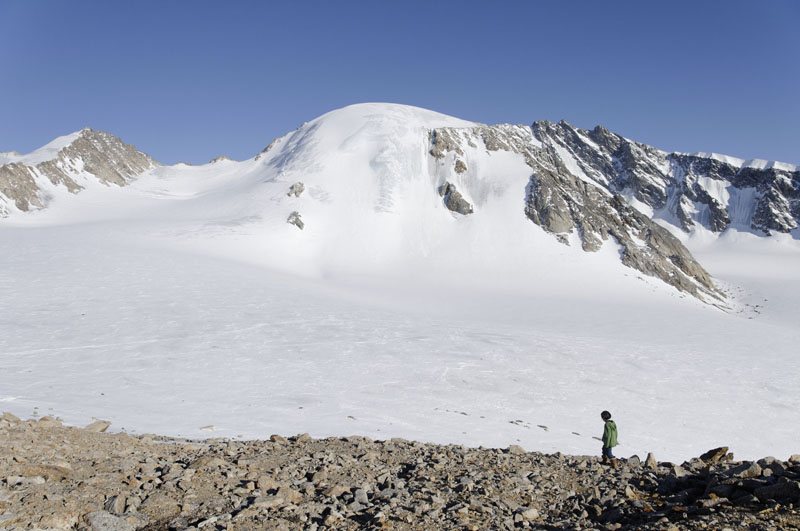
Turner liked to go out to his "thinking rock" and check
the weather. |
|
|
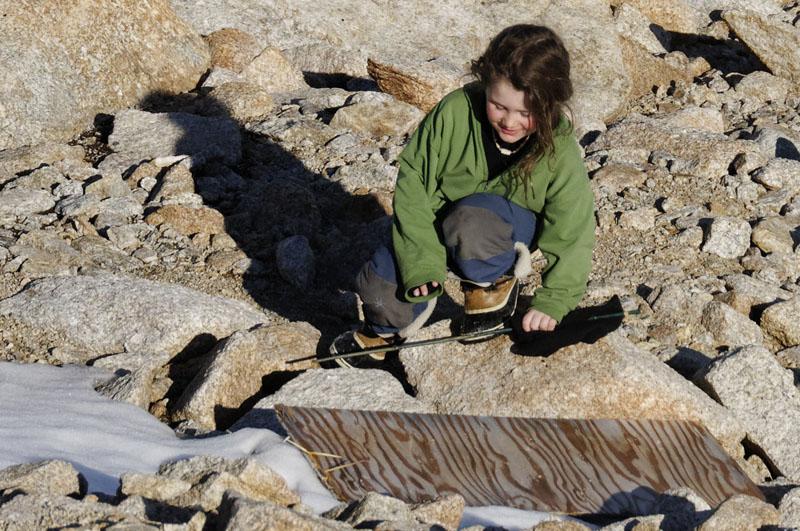
Not far away, we found the lid to one of my battery boxes that
had blown off over the winter.

Keith was always trying to be center of attention.

Service with a smile.

"Just cleaning the glassware mate"
27 May 2011 Fairbanks
Well, the problem with the
snow machines was clearly related to gas. We pumped some different
gas into the yellow one after draining it into a waste can and
it fired right up and worked fine. The others spent some time
on the glacier moving gear around for final disposition before
coming back up to camp to help break down tents. I spent the morning
and afternoon sorting through my science gear and getting it ready
to ship out. In the meantime, Kristin and Turner packed up the
inside of the cook tent. After a nice dinner, we hauled everything
out and took the cook tent apart. It was a nice evening, and everyone
was in exceptionally good spirits, probably in part thanks to
the spirits we polished off to reduce our take-out loads. After
it was down and everyone went back to their tents to work on personal
gear or sleep, the Nolans took a nice family photo in front of
the camp weather station, which had died irreparably over the
winter.
The next morning, our take-out
date, started with clear skies, but the wind had picked up around
camp after Dirk launched to pick us up. The clear sky overnight
had solidified the snow so that walking on it was once again easy,
and hopefully the aircraft would have an easier time of it too.
The general plan was for Andy and Mike to leave first with their
gear, flying to Okpilak Lake where they would meet Bob and take
a sediment core for pollen. Unfortunately the weather in Deadhorse,
where Bob was, was foggy and he could not leave. Further, when
Dirk arrived he reported that the entire coastal plain was in
fog and that Okpilak Lake was ringed by water already. His flight
limits prevented him from doing two shuttles back to Coldfoot,
so we sent Andy and Mike back to Coldfoot and planned for another
day on the glacier. By noon when they left the snow was softening
up and the air felt quite hot, and our pace slowed down given
the lack of rush required. It was 2:30PM by the time I got back
up to camp. Kristin and Turner went down to the glacier to pull
some food and supplies from the take-out load, and I took a nap
as some clouds had moved in and I was behind on sleep. By 5PM,
the skies had turned clear again and there was not a trace of
wind. We enjoyed a nice picnic dinner in the open air, where the
cook tent had been set up, and relaxed and chatted in the outstanding
views surrounding us. It reminded me a bit of the weenie-roast
we had on the Jago River last August, with the stress of the trip
mostly over and just some time to enjoy the company and location.
The next morning started much
like the previous one, with clear skies and some wind. The wind
wasnt awful, but it doesnt take much to bring the apparent temperature
down and add to the drama. Things like setting up tarps in the
wind become a several person job, and it just makes things feel
a bit more desperate than they are. But by noon we were all packed
and on the glacier when Dirk arrived. Deadhorse was still in fog,
and we gave up on the sediment coring project and focused on just
getting out. The snow was still not exceptional, so we reduced
our individual loads, getting as much weight forward, and sent
Kristin and Turner out first to Shrader Lake, where we would meet
up in a few hours. Keith and I cached the snow machines and were
barely done by the time Dirk returned. The weather was still great,
and soon we were reunited on the lake, which had by now lost nearly
all of its snow. The valleys were also nearly empty of snow too.
It was unclear how much there was to begin with, but the recent
warm, windy weather from the south had clearly caused most of
it to disappear. The main rivers were open, and many glacier creeks
had started flowing too. McCall Glacier had probably 50% of its
surface exposed with ice, with very little remaining below the
confluence of the cirques. It will be interesting to see how the
USGS stream gaged fared on the Hulahula River and what data it
has to share, as this is its first full year of operation.
The flight home was uneventful,
and soon we were back in Coldfoot and reunited with the others,
who had spent the night there. We enjoyed hot showers at the Inn
and a meal before packing up our cars and heading for Fairbanks.
We stopped at all of the major attractions on the way for photos
and leg-stretching, and even met Mike from 70N along the way,
driving his minni-winnie to Deadhorse for the season. Along the
way I daydreamed about driving the road in the future just for
photographs, and maybe combining these with air photos along the
same route, for some sort of coffee table book. It was nearly
3AM by the time we got to our house, though still bright out in
the midnight sun. We wound down, found everyone a place to sleep,
and crashed.
|
|
|
|
|
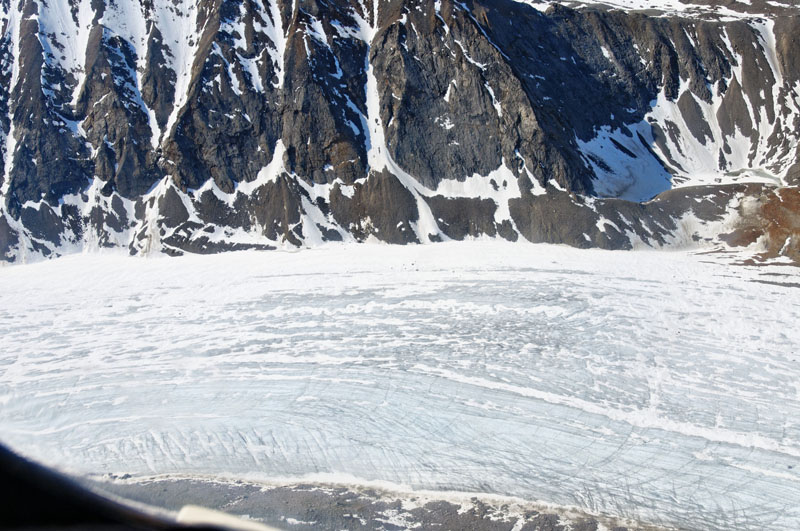
|
|
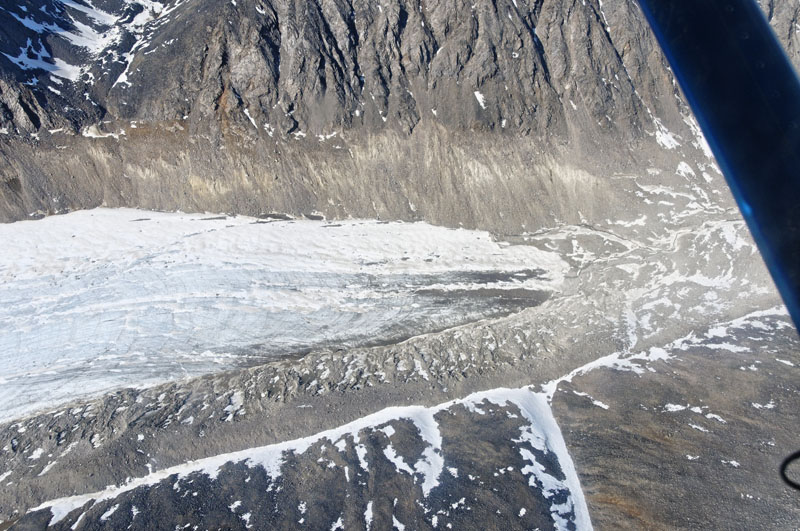
|
|
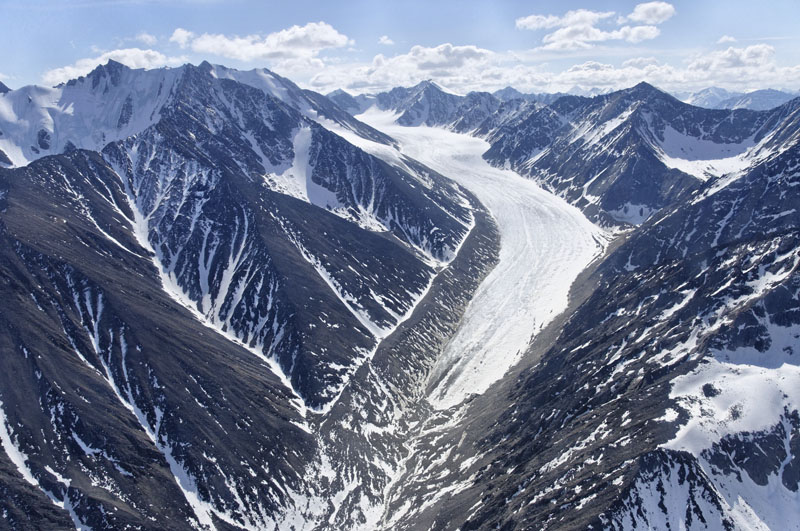
|
|
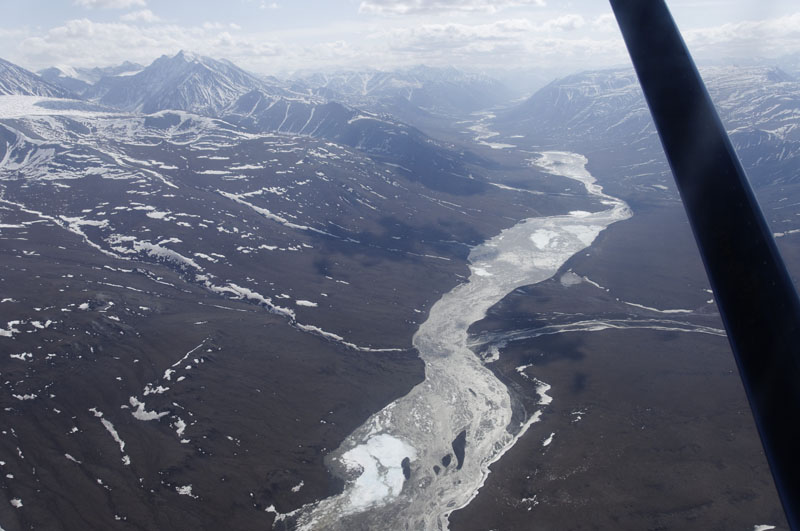
The valleys were also almost snow free, and the rivers had started
running a bit, but it was still below freezing here so the snow
melt 'peak' hadnt really happened yet. |
|
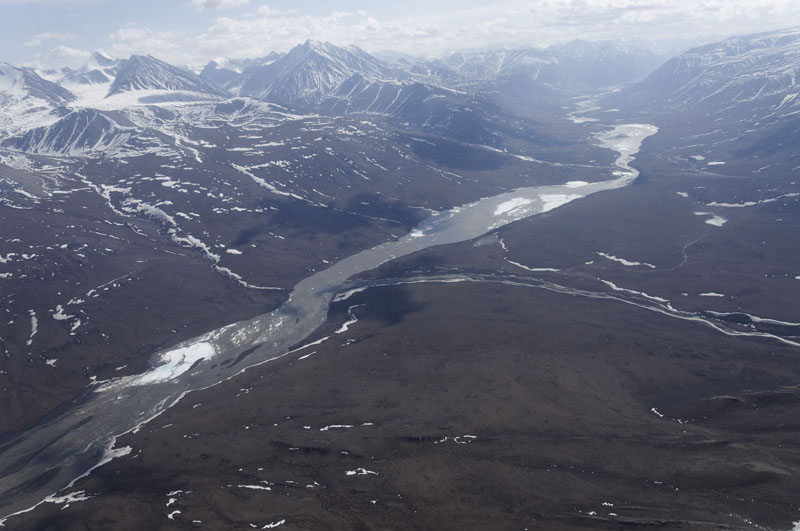
|
|
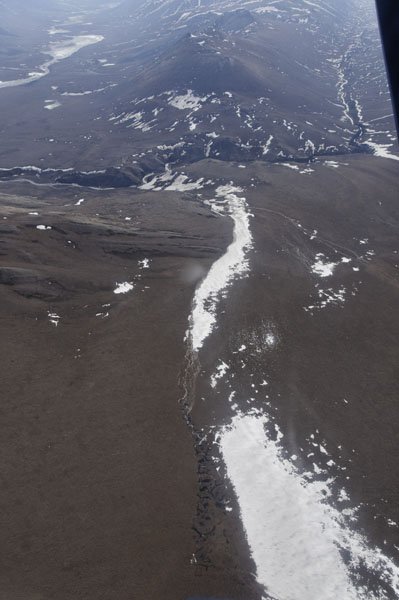
|
|
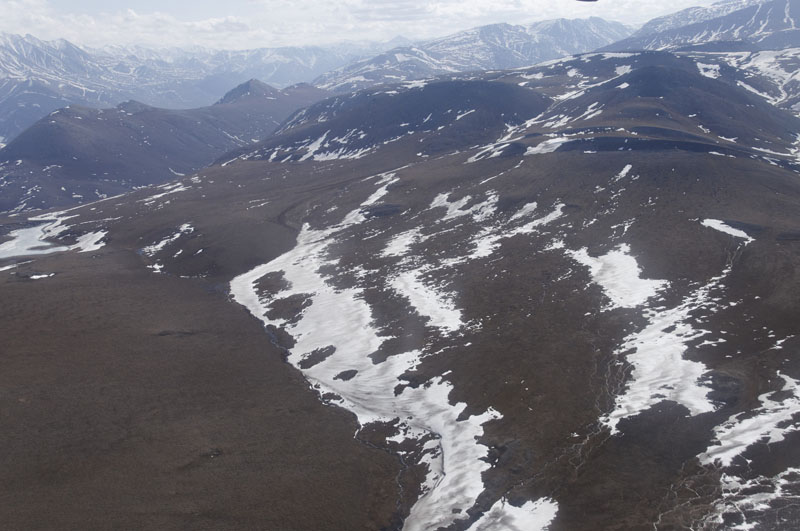
|
|
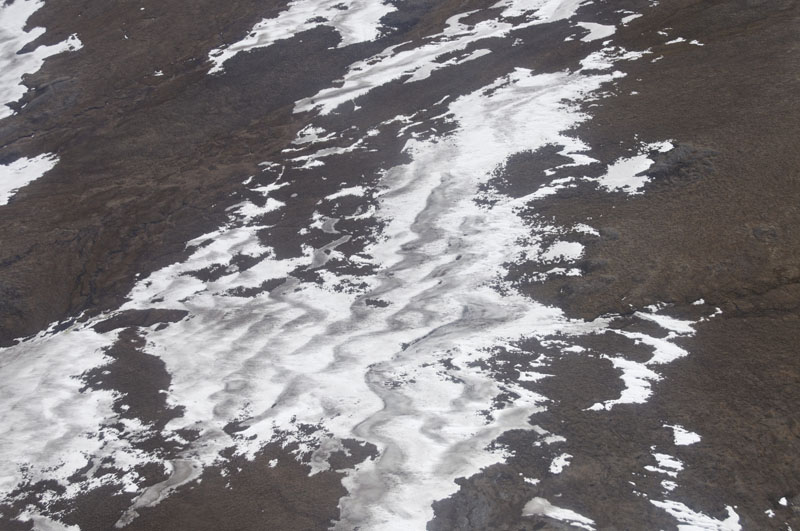
|
|
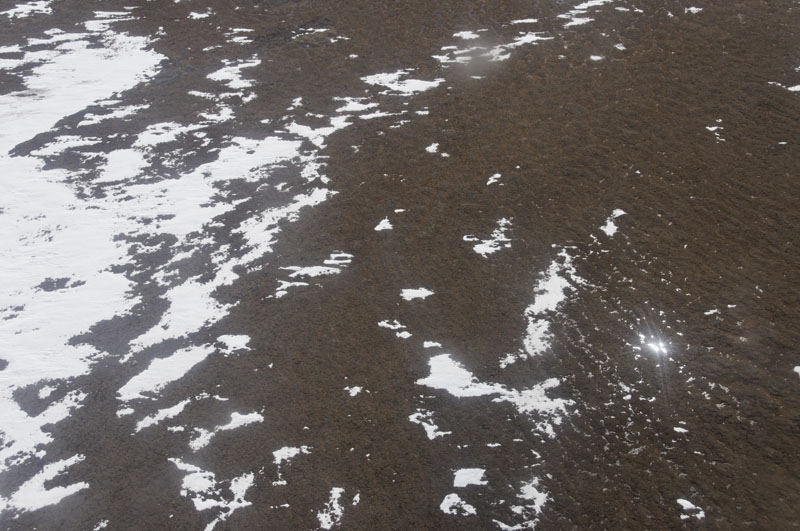
|
|
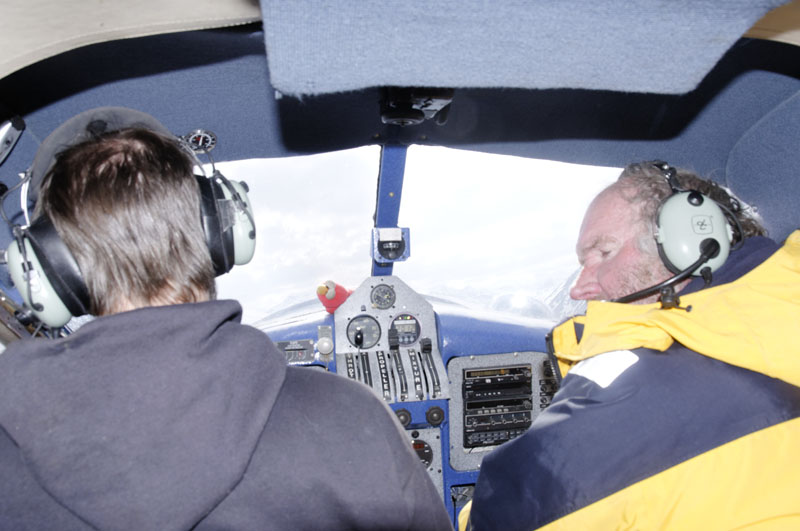
"How about we arm wrestle for the plane?" |
|
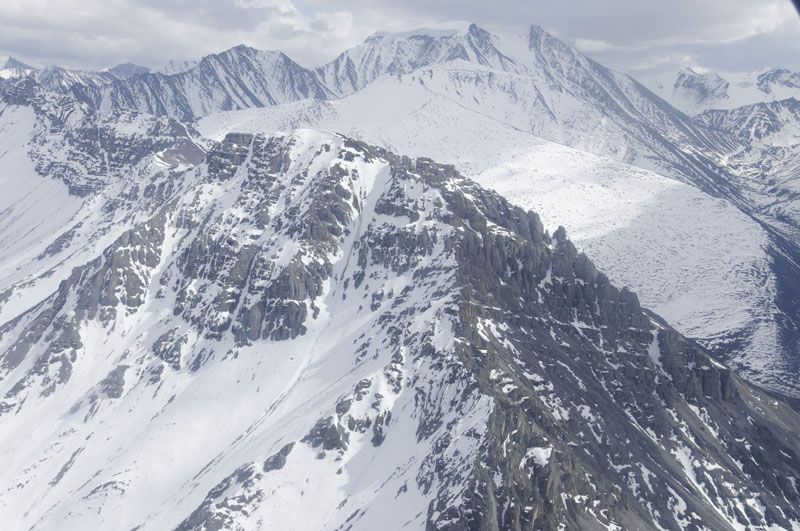
|
|
|
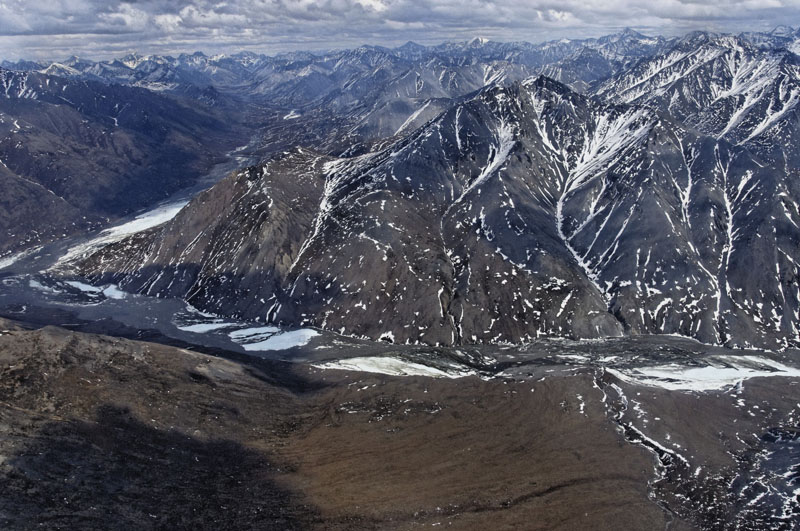

On the lake, reuniting and reorganizing.

And refueling.

|
|
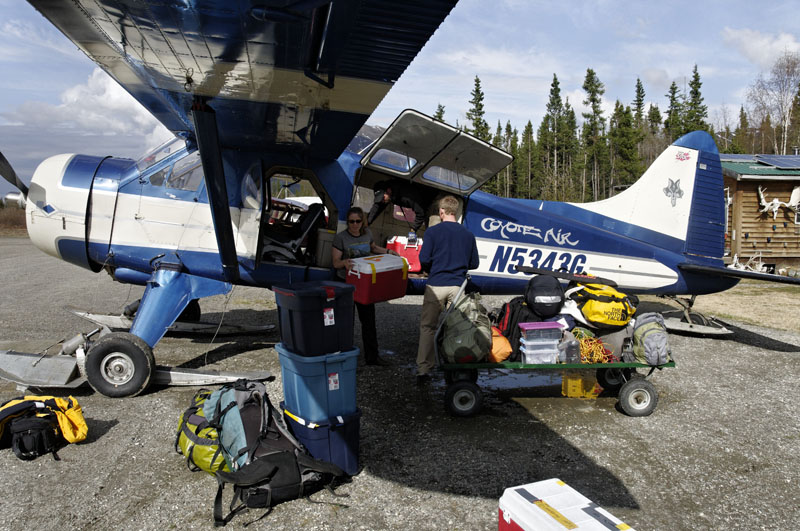
|
|
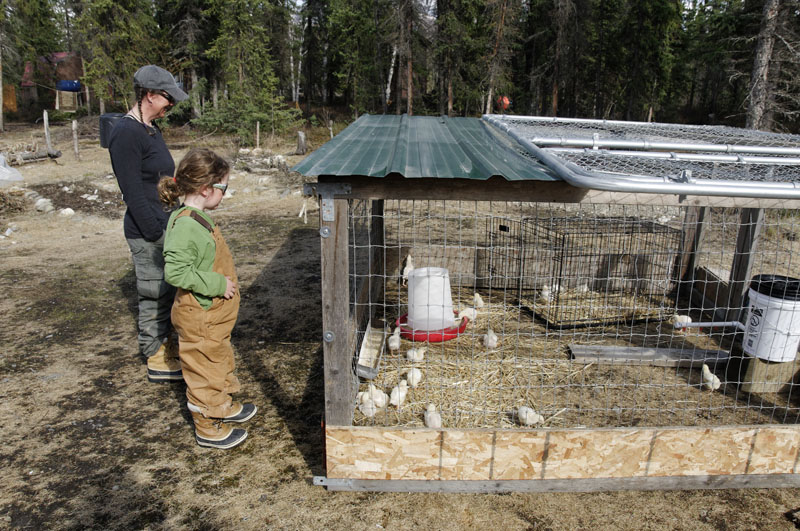
|
|
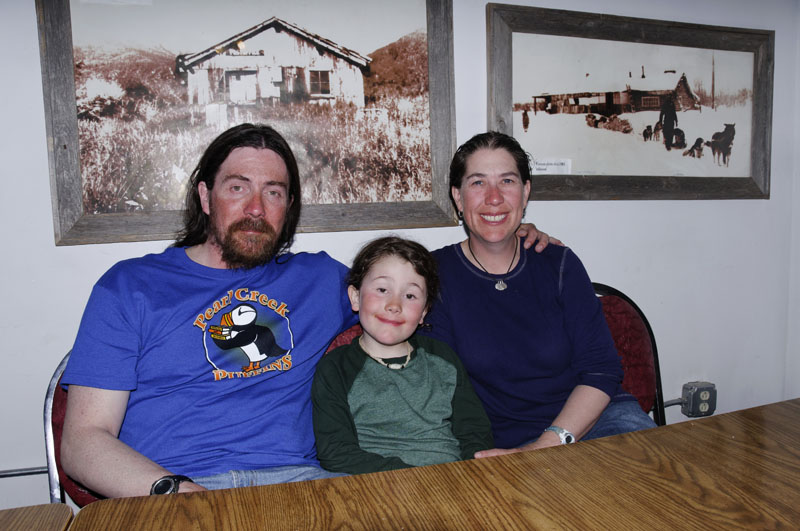
"What do you mean we're not sleeping here?" |
|
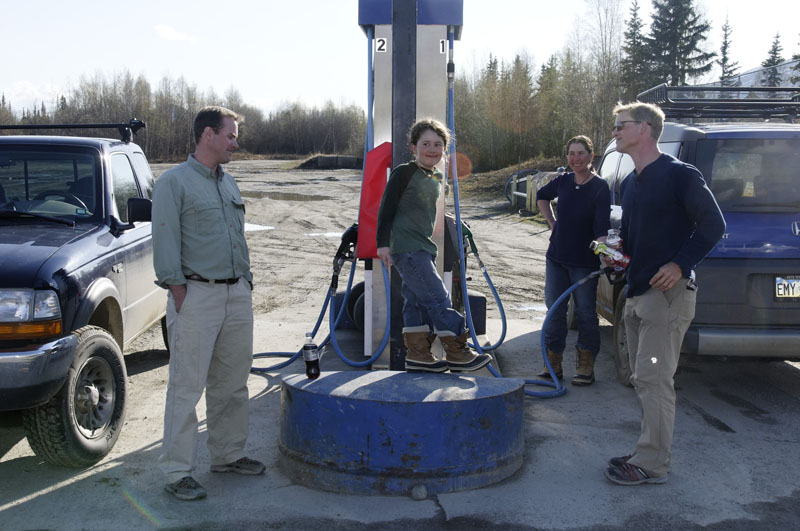
Time to gas and go. |
|
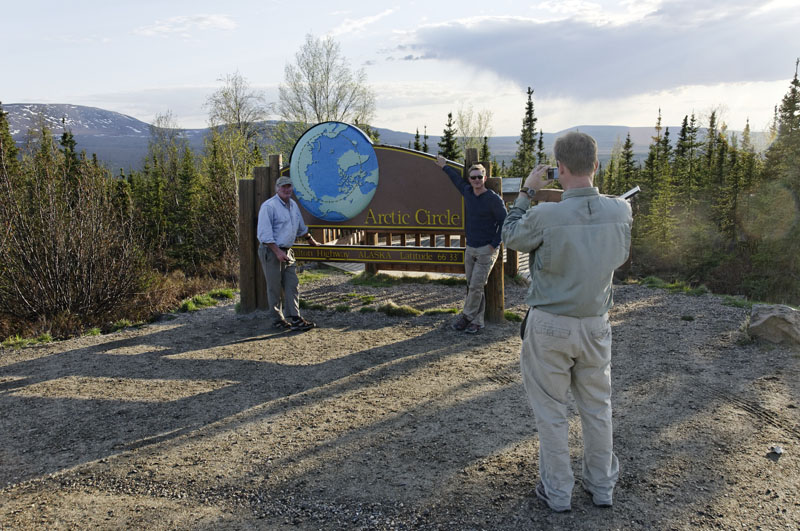
|
|
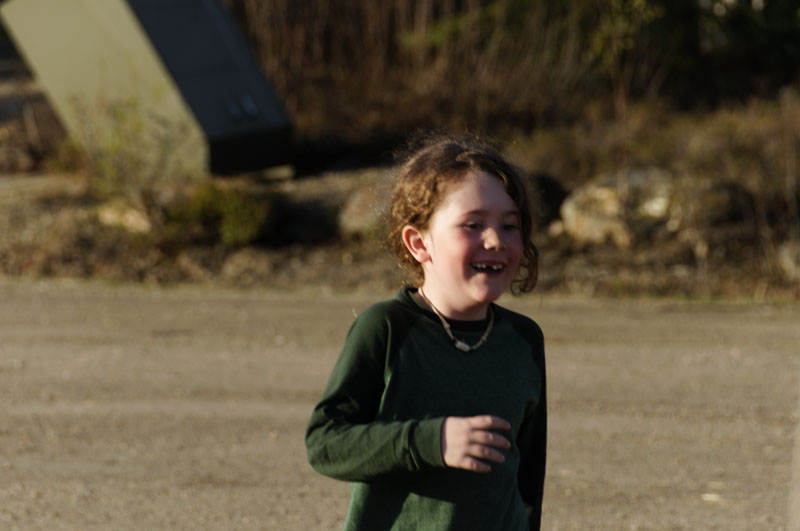
|
|
|
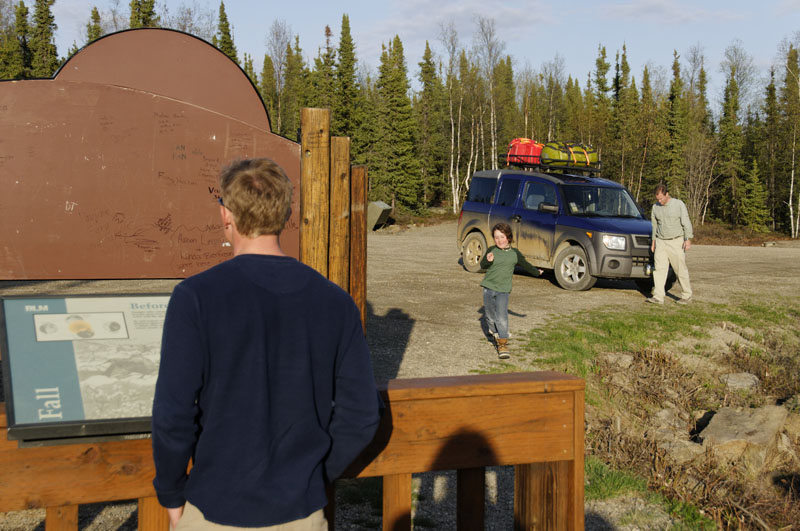


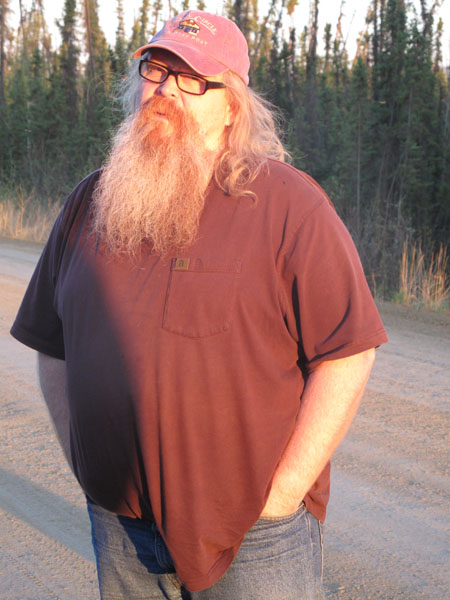

Our sleep was short-lived,
as Turner was up early, as did some of the others. All were due
to leave today on flights home. We repacked and headed out, stopping
first at Fred Meyers for souvenirs to take home, then enjoyed
lunch and beers on the deck at Pikes. Tourist season was clearly
ramping up, as old folks wearing safari gear were milling about
looking for an Alaskan adventure in the hotel lobby and there
were many tour busses on the road. We said goodbye to Andy and
Mike at the airport hotel they had stashed gear at, and the rest
of us went to see an art show where I had donated some photos
for a show hosted by the Northern Alaska Environmental Center
on the Arctic Refuge. It was nice to get some cultcha, and I was
happily surprised to see that one of my prints had been sold for
$350, the proceeds going to the Center. We swung by the airplane
to see how it had fared in our absence, and Kristin and Keith
taxied around a bit to test the new wheels, as the weather looked
a bit rough up high. By this time it was nearly dinner time, so
we headed back to Pikes for another dose of the deck before dropping
Keith off at the airport. And then it was just us again. |
|
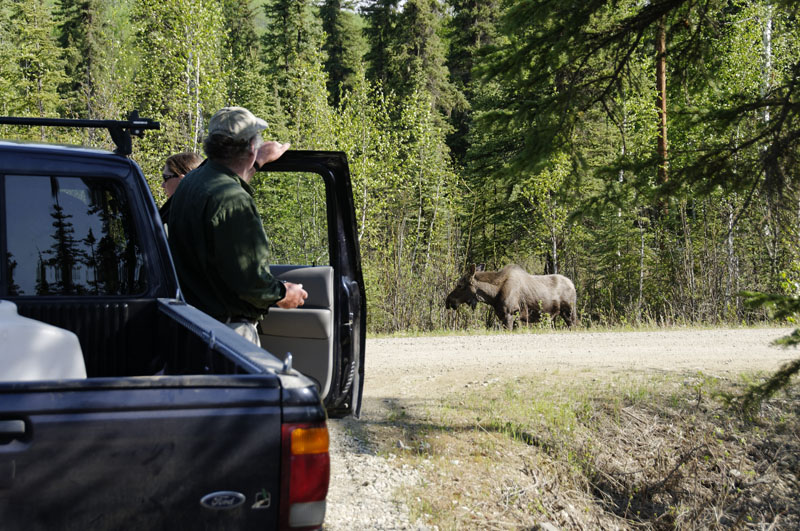
Having not seen any wildlife on the trip, we contracted with the
neighbors to give the boys their photos. |
|
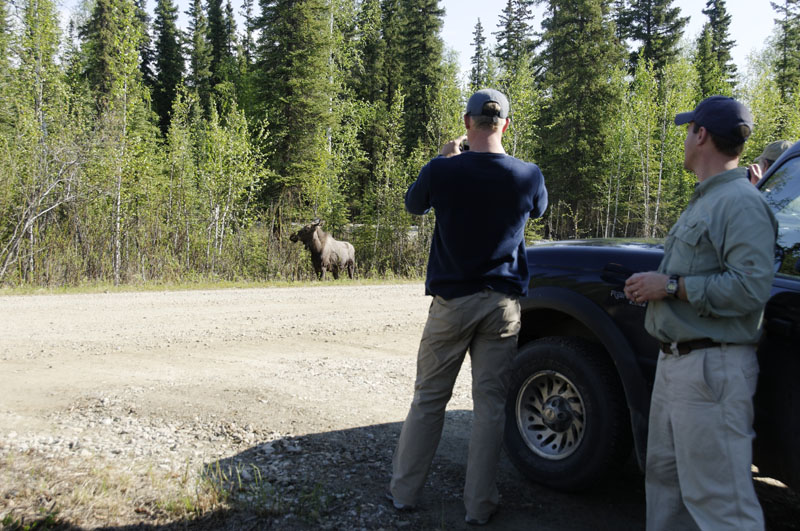
|
|
|
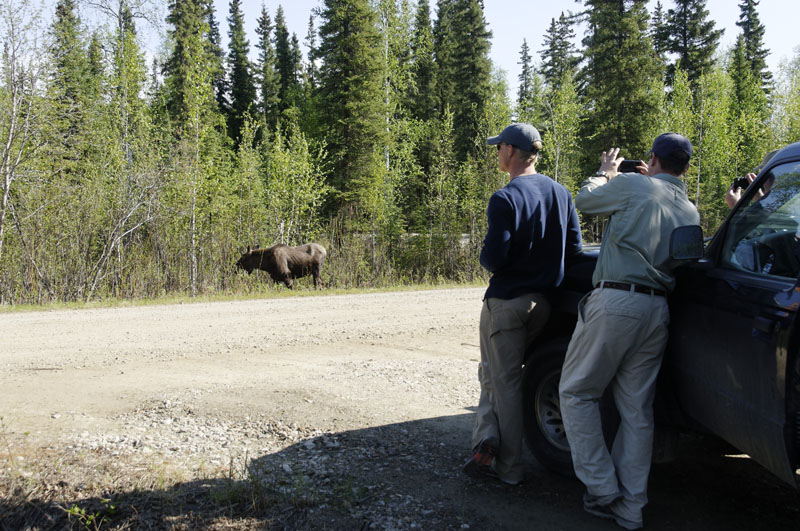

Victory lunch.
|
|
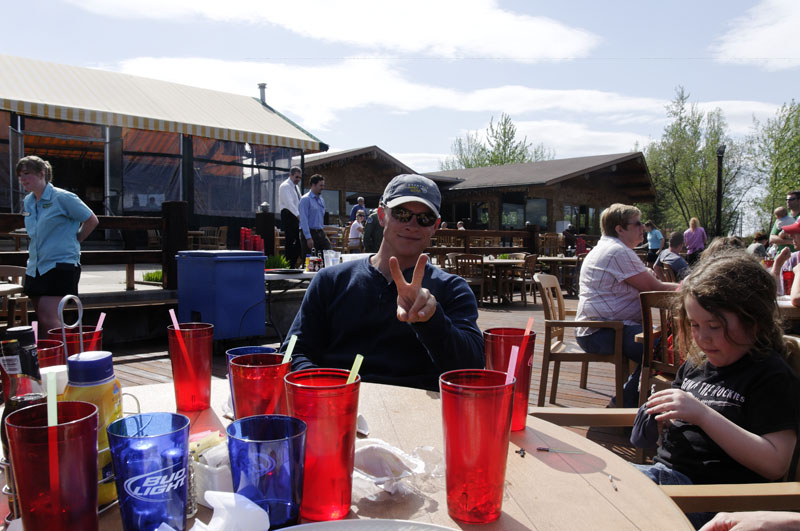
|
|
|
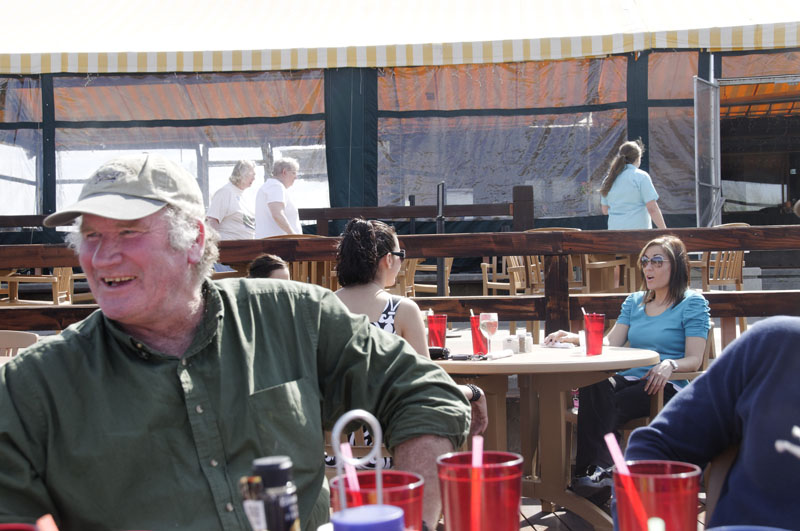
I think Keith nearly had a heart attack when a pretty girl offered
to use his camera to take our picture.
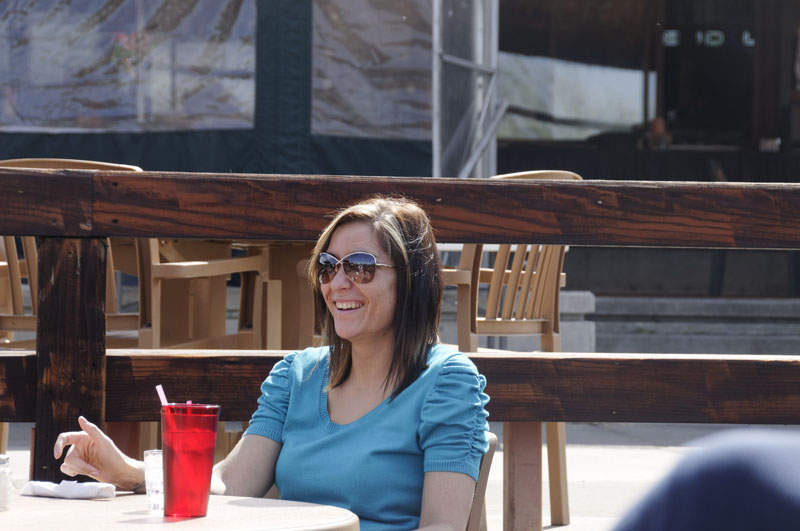
"I wasnt proposing to him..."

I thought this visor made I made from nearby garbage was pretty
clever, but Kristin didnt think so.

Still in one piece.
The gear from the trip was
just stacked in piles in our driveway, but we had no motivation
to deal with it. Though we had been together for the past month,
we really hadnt had much time to ourselves. We started one of
Turner's new movies, but I think we all fell asleep during it
and spent the night together on the couch. It's now two days later,
and Kristin and Turner are at the laundramat washing gear to get
ready for our next trip, which starts next week. I checked email,
and was pleasantly surprised to find only 100 emails in my inbox,
one of which was an award letter for a new grant to expand our
studies at McCall Glacier to include glacier-estuary interactions
with a group from Texas. That was the only good news really, as
I found there were plenty of new fires to put out over the next
week. We did manage to have a picnic in the park in the meantime,
where Turner was very excited about being able to run in a straight
line without having to rock-hop or slip on ice. But now its back
to work again. It's Memorial Day weekend, which is going to slow
down preparations as most sane people are out enjoying themselves,
but the work we have planned was expected and a small price to
pay for the benefits we get out of it. We have a long and busy
summer ahead of us, but so far we are still managing to make it
all work for us and take satisfaction in the studies we are able
to accomplish together.

|
|
|

